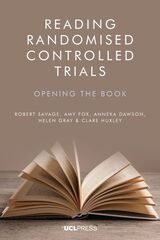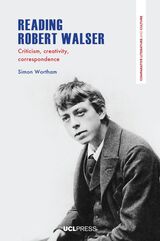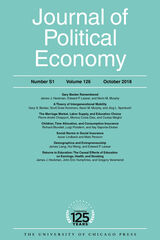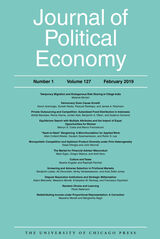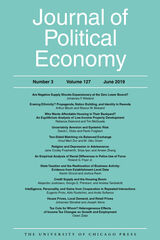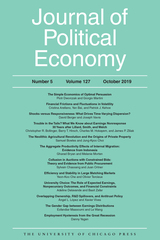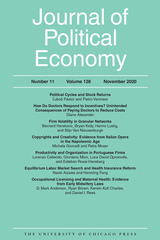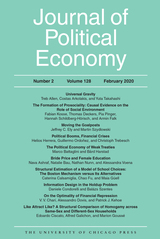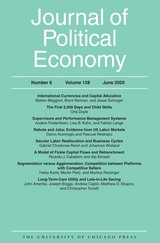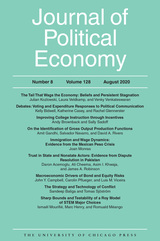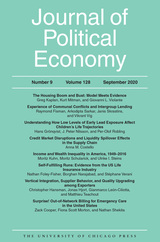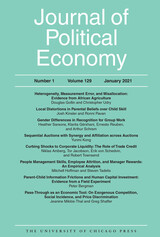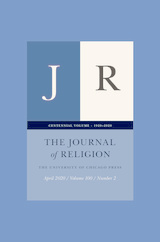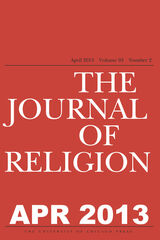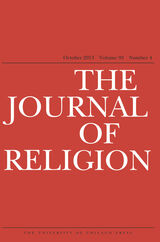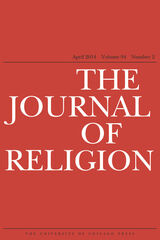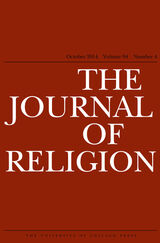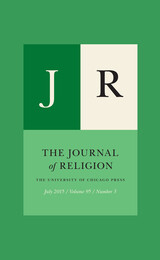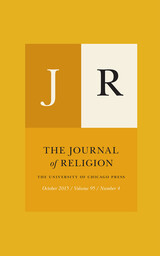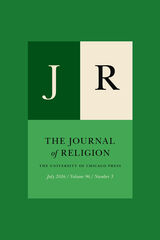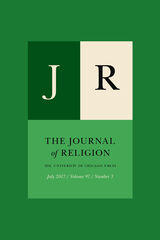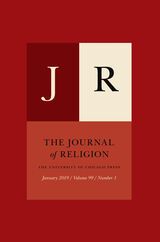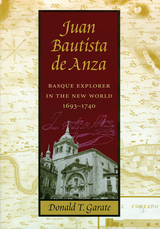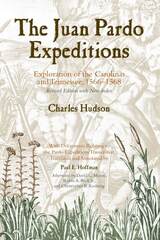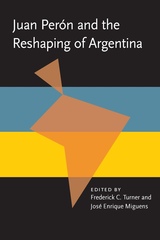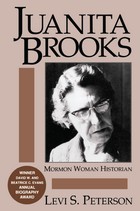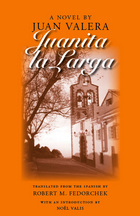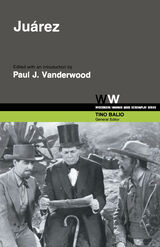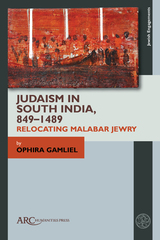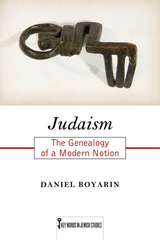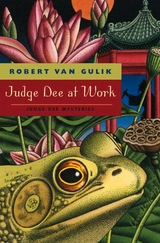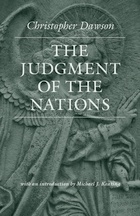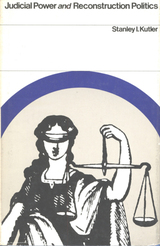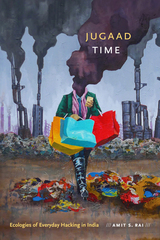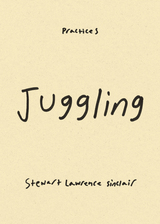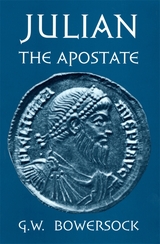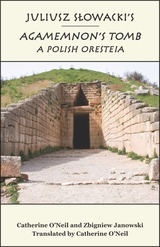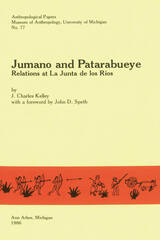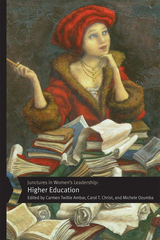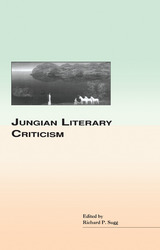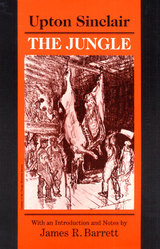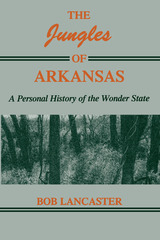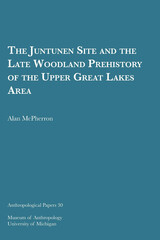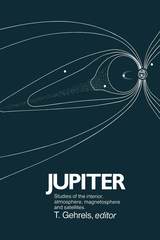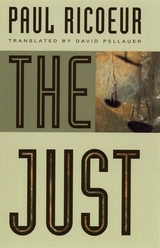JPE vol 126 num S1
The University of Chicago Press
University of Chicago Press Journals, 2018
JPE vol 127 num 1
The University of Chicago Press
University of Chicago Press Journals, 2019
JPE vol 127 num 2
The University of Chicago Press
University of Chicago Press Journals, 2019
JPE vol 127 num 3
The University of Chicago Press
University of Chicago Press Journals, 2019
JPE vol 127 num 4
The University of Chicago Press
University of Chicago Press Journals, 2019
JPE vol 127 num 5
The University of Chicago Press
University of Chicago Press Journals, 2019
JPE vol 127 num 6
The University of Chicago Press
University of Chicago Press Journals, 2019
JPE vol 128 num 1
The University of Chicago Press
University of Chicago Press Journals, 2020
JPE vol 128 num 10
The University of Chicago Press
University of Chicago Press Journals, 2020
JPE vol 128 num 11
The University of Chicago Press
University of Chicago Press Journals, 2020
JPE vol 128 num 12
The University of Chicago Press
University of Chicago Press Journals, 2020
JPE vol 128 num 2
The University of Chicago Press
University of Chicago Press Journals, 2020
JPE vol 128 num 3
The University of Chicago Press
University of Chicago Press Journals, 2020
JPE vol 128 num 4
The University of Chicago Press
University of Chicago Press Journals, 2020
JPE vol 128 num 5
The University of Chicago Press
University of Chicago Press Journals, 2020
JPE vol 128 num 6
The University of Chicago Press
University of Chicago Press Journals, 2020
JPE vol 128 num 7
The University of Chicago Press
University of Chicago Press Journals, 2020
JPE vol 128 num 8
The University of Chicago Press
University of Chicago Press Journals, 2020
JPE vol 128 num 9
The University of Chicago Press
University of Chicago Press Journals, 2020
JPE vol 129 num 1
The University of Chicago Press
University of Chicago Press Journals, 2021
JPE vol 129 num 2
The University of Chicago Press
University of Chicago Press Journals, 2021
JPE vol 129 num 3
The University of Chicago Press
University of Chicago Press Journals, 2021
JPS Tanakh: The Jewish Bible, Audio Version
JPS: The Jewish Publication Society
Jewish Publication Society, 2009 The JPS TANAKH: The Jewish Bible, audio version is a recorded version of the JPS TANAKH, the most widely read English translation of the Hebrew, or Jewish, Bible. Produced and recorded for The Jewish Publication Society (JPS) by The Jewish Braille Institute (JBI), this complete, unabridged audio version features over 60 hours of readings by 13 narrators
Regarded throughout the English-speaking world as the standard English translation of the Holy Scriptures, the JPS TANAKH has been acclaimed by scholars, rabbis, lay leaders, Jews, and Christians alike.
The JPS TANAKH is an entirely original translation of the Holy Scriptures into contemporary English, based on the Masoretic (the traditional Hebrew) text. It is the culmination of three decades of collaboration by academic scholars and rabbis, representing the three largest branches of organized Judaism in the United States.
JR vol 100 num 1
The University of Chicago Press
University of Chicago Press Journals, 2020
JR vol 100 num 2
The University of Chicago Press
University of Chicago Press Journals, 2020
JR vol 100 num 3
The University of Chicago Press
University of Chicago Press Journals, 2020
JR vol 100 num 4
The University of Chicago Press
University of Chicago Press Journals, 2020
JR vol 93 num 1
The University of Chicago Press
University of Chicago Press Journals, 2013
JR vol 93 num 2
The University of Chicago Press
University of Chicago Press Journals, 2013
JR vol 93 num 3
The University of Chicago Press
University of Chicago Press Journals, 2013
JR vol 93 num 4
The University of Chicago Press
University of Chicago Press Journals, 2013
JR vol 94 num 1
The University of Chicago Press
University of Chicago Press Journals, 2014
JR vol 94 num 2
The University of Chicago Press
University of Chicago Press Journals, 2014
JR vol 94 num 3
The University of Chicago Press
University of Chicago Press Journals, 2014
JR vol 94 num 4
The University of Chicago Press
University of Chicago Press Journals, 2014
JR vol 95 num 1
The University of Chicago Press
University of Chicago Press Journals, 2015
JR vol 95 num 2
The University of Chicago Press
University of Chicago Press Journals, 2015
JR vol 95 num 3
The University of Chicago Press
University of Chicago Press Journals, 2015
JR vol 95 num 4
The University of Chicago Press
University of Chicago Press Journals, 2015
JR vol 96 num 1
The University of Chicago Press
University of Chicago Press Journals, 2016
JR vol 96 num 2
The University of Chicago Press
University of Chicago Press Journals, 2016
JR vol 96 num 3
The University of Chicago Press
University of Chicago Press Journals, 2016
JR vol 96 num 4
The University of Chicago Press
University of Chicago Press Journals, 2016
JR vol 97 num 1
The University of Chicago Press
University of Chicago Press Journals, 2017
JR vol 97 num 2
The University of Chicago Press
University of Chicago Press Journals, 2017
JR vol 97 num 3
The University of Chicago Press
University of Chicago Press Journals, 2017
JR vol 97 num 4
The University of Chicago Press
University of Chicago Press Journals, 2017
JR vol 98 num 1
The University of Chicago Press
University of Chicago Press Journals, 2018
JR vol 98 num 2
The University of Chicago Press
University of Chicago Press Journals, 2018
JR vol 98 num 3
The University of Chicago Press
University of Chicago Press Journals, 2018
JR vol 98 num 4
The University of Chicago Press
University of Chicago Press Journals, 2018
JR vol 99 num 1
The University of Chicago Press
University of Chicago Press Journals, 2019
JR vol 99 num 2
The University of Chicago Press
University of Chicago Press Journals, 2019
JR vol 99 num 3
The University of Chicago Press
University of Chicago Press Journals, 2019
JR vol 99 num 4
The University of Chicago Press
University of Chicago Press Journals, 2019
 Jua Kali Kenya: Change and Development in an Informal Economy, 1970–1995
Kenneth King
Ohio University Press, 1996 Kenya was where the term “informal sector” was first used in 1971. During the 1980s the term “jua kali” — in Swahili “hot sun” — came to be used of the informal sector artisans, such as carworkers and metalworkers, who were working under the hot sun because of a lack of premises. Gradually it came to refer to anybody in self-employment. And in 1988 the government set up the Jua Kali Development Programme.
In this remarkable book Kenneth King brings the subject alive through the photographs and life histories of jua kali people. He has also revisited, twenty years later, many of the artisans whom he interviewed exhaustively in the period from 1972 to 1974 and about whom he wrote in The African Artisan, one of the first full-length studies to be published on the informal sector.
For donors, NGOs, and national governments, the book offers many relevant examples, and some cautions, about what has been achieved by ordinary Kenyans, mostly without government support. It will prove equally valuable for students and teachers of development policy, technology policy, and education and training policies not least because of its superb bibliography of over 700 entries related to small enterprise development.
Juan Bautista de Anza: Basque Explorer in the New World, 1693-1740
Donald T. Garate
University of Nevada Press, 2005 The first biography of an eighteenth-century Basque immigrant who became a silver miner, a cattle rancher, and commander of the cavalry in Sonora, Mexico. The name of Juan Bautista de Anza the younger is a fairly familiar one in the contemporary Southwest because of the various streets, schools, and other places that bear his name. Few people, however, are familiar with his father, the elder Juan Bautista de Anza, whose activities were crucial to the survival of the tenuous and far-flung settlements of Spain’s northernmost colonial frontier. For this first comprehensive biography of the elder Anza, Donald T. Garate spent more than ten years researching archives in Spain and the Americas. The result is a lively picture of the Spanish borderlands and the hardy, ambitious colonists who peopled them.
 Juan de Segovia and the Fight for Peace: Christians and Muslims in the Fifteenth Century
Anne Marie Wolf
University of Notre Dame Press, 2014 Juan de Segovia (d. 1458), theologian, translator of the Qur'an, and lifelong advocate for the forging of peaceful relations between Christians and Muslims, was one of Europe's leading intellectuals. Today, however, few scholars are familiar with this important fifteenth-century figure. In this well-documented study, Anne Marie Wolf presents a clear, chronological narrative that follows the thought and career of Segovia, who taught at the University of Salamanca, represented the university at the Council of Basel (1431–1449), and spent his final years arguing vigorously that Europe should eschew war with the ascendant Ottoman Turks and instead strive to convert them peacefully to Christianity.
What could make a prominent thinker, especially one who moved in circles of power, depart so markedly from the dominant views of his day and advance arguments that he knew would subject him to criticism and even ridicule? Although some historians have suggested that the multifaith heritage of his native Spain accounts for his unconventional belief that peaceful dialogue with Muslims was possible, Wolf argues that other aspects of his life and thought were equally important. For example, his experiences at the Council of Basel, where his defense of conciliarism in the face of opposition contributed to his ability to defend an unpopular position and where his insistence on conversion through peaceful means was bolstered by discussions about the proper way to deal with the Hussites, refined his arguments that peaceful conversion was prefereable to war. Ultimately Wolf demonstrates that Segovia's thought on Islam and the proper Christian stance toward the Muslim world was consistent with his approach to other endeavors and with cultural and intellectual movements at play throughout his career.
"This comprehensive study examines an important figure in the history of the fifteenth-century Catholic Church, Juan de Segovia, who is known both as a leading conciliarist and as an advocate of a more pacific manner of dealing with and proselytizing Muslims. Anne Marie Wolf does an excellent job of tying together the different strands of Juan's life and career. The book will interest historians of Spain, of the Catholic Church, and of Christian-Muslim relations in the premodern world." —Mark Meyerson, University of Toronto
"Juan de Segovia was one of the four or five most interesting interpreters of Islam in premodern Europe. In this meticulous, beautifully written, and deeply thoughtful book, Anne Marie Wolf presents his complicated views on medieval Christendom's great rival in the rich detail that they deserve, and gracefully illuminates his insistent search for peaceful modes of Christian-Muslim interaction. Essential reading for all scholars of the long encounter between Christianity and Islam." —Thomas E. Burman, University of Tennessee
"Anne Marie Wolf's book, Juan de Segovia and the Fight for Peace, is a well-researched and lucid investigation into the thought of this important fifteenth-century theologian, especially his ideas on Muslim-Christian relations. Wolf's discussion of several of Segovia's lesser known early works and her well-informed focus on the Iberian context of his thought offer important new insights into Segovia's role as an advocate of late medieval conciliarism and as a proponent of peaceful resolution to interreligious conflict. This is a significant and timely contribution to the study of this remarkable fifteenth-century Spanish ecclesiastic." —Jesse D. Mann, Drew University and Montclair University
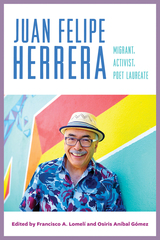 Juan Felipe Herrera: Migrant, Activist, Poet Laureate
Edited by Francisco A. Lomelí and Osiris Aníbal Gómez
University of Arizona Press, 2023 For the first time, this book presents the distinguished, prolific, and highly experimental writer Juan Felipe Herrera. This wide-ranging collection of essays by leading experts offers critical approaches on Herrera, who transcends ethnic and mainstream poetics. It expertly demonstrates Herrera’s versatility, resourcefulness, innovations, and infinite creativity.
As a poet Herrera has had an enormous impact within and beyond Chicano poetics. He embodies much of the advancements and innovations found in American and Latin American poetry from the early l970s to the present. His writings have no limits or boundaries, indulging in the quotidian as well as the overarching topics of his era at different periods of his life. Both Herrera and his work are far from being unidimensional. His poetics are eclectic, incessantly diverse, transnational, unorthodox, and distinctive.
Reading Herrera is an act of having to rearrange your perceptions about things, events, historical or intra-historical happenings, and people. The essays in this work delve deeply into Juan Felipe Herrera’s oeuvre and provide critical perspectives on his body of work. They include discussion of Chicanx indigeneity, social justice, environmental imaginaries, Herrera’s knack for challenging theory and poetics, transborder experiences, transgeneric constructions, and children’s and young adult literature.
This book includes an extensive interview with the poet and a voluminous bibliography on everything by, about, and on the author. The chapters in this book offer a deep dive into the life and work of an internationally beloved poet who, along with serving as the poet laureate of California and the U.S. poet laureate, creates work that fosters a deep understanding of and appreciation for people’s humanity. Contributors
Trevor Boffone
Marina Bernardo-Flórez
Manuel de Jesús Hernández-G.
Whitney DeVos
Michael Dowdy
Osiris Aníbal Gómez
Carmen González Ramos
Cristina Herrera
María Herrera-Sobek
Francisco A. Lomelí
Tom Lutz
Manuel M. Martín-Rodríguez
Marzia Milazzo
Maria Antònia Oliver-Rotger
Rafael Pérez-Torres
Renato Rosaldo
Donaldo W. Urioste
Luis Alberto Urrea
Santiago Vaquera-Vásquez
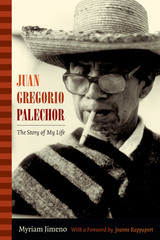 Juan Gregorio Palechor: The Story of My Life
Myriam Jimeno Translated by Andy Klatt
Duke University Press, 2014 The Colombian activist Juan Gregorio Palechor (1923–1992) dedicated his life to championing indigenous rights in Cauca, a department in the southwest of Colombia, where he helped found the Regional Indigenous Council of Cauca. Recounting his life story in collaboration with the Colombian anthropologist Myriam Jimeno, Palechor traces his political awakening, his experiences in national politics, the disillusionment that resulted, and his turn to a more radical activism aimed at confronting ethnic discrimination and fighting for indigenous territorial and political sovereignty.
Palechor's lively memoir is complemented by Jimeno's reflections on autobiography as an anthropological tool and on the oppressive social and political conditions faced by Colombia's indigenous peoples. A faithful and fluent transcription of Palechor's life story, this work is a uniquely valuable resource for understanding the contemporary indigenous rights movements in Colombia.
 Juan Luna's Revolver
Luisa A. Igloria
University of Notre Dame Press, 2009
The poems in Juan Luna' s Revolverboth address history and attempt to transcend it through their exploration of the complexity of diaspora. Attending to the legacy of colonial and postcolonial encounters, Luisa A. Igloria has crafted poems that create links of sympathetic human understanding, even as they revisit difficult histories and pose necessary questions about place, power, displacement, nostalgia, beauty, and human resilience in conditions of alienation and duress.
Igloria traces journeys made by Filipinos in the global diaspora that began since the encounter with European and American colonial power. Her poems allude to historical figures such as the Filipino painter Juan Luna and the novelist and national hero José Rizal, as well as the eleven hundred indigenous Filipinos brought to serve as live exhibits in the 1904 Missouri World’s Fair. The image of the revolver fired by Juan Luna reverberates throughout the collection, raising to high relief how separation and exile have shaped concepts of identity, nationality, and possibility.
Suffused with gorgeous imagery and nuanced emotion, Igloria’s poetry achieves an intimacy fostered by gem-like phrases set within a politically-charged context speaking both to the personal and the collective.
"In Juan Luna's Revolver, Luisa Igloria establishes herself as a singular and revelatory voice in American poetry. Here, she explores the dichotomy of Filipino: interwoven yet hermetically singular, acquisitive yet inventive, docile yet amok. Her engrossing poems hide, behind their gorgeous scrims, a bristling wall of spears." —Sabina Murray, author of Forgery, A Carnivore's Inquiry, and The Caprices
“When I read a Luisa Igloria poem, a bright enchanted light falls over my being. Juan Luna’s Revolver is Igloria’s best work to date. These poems never let us forget they are wrought from an immigrant's love for family, country, and the history of the reinvented self.” —Virgil Suarez, author of 90 Miles
" 'What a world to have lived in, to have arrived in,' Luisa Igloria writes early on in this brilliant collection that explores colonization and cultural displacement, and how the artist must live in the aftermath of both. Even when she writes about places many miles away, Igloria constructs a luminous portrait of what is utterly human and ultimately familiar. These poems reveal a poet devoted to the truth of her craft." —Honorée Fanonne Jeffers, author of Outlandish Blues and Red Clay Suite
“In sure and compelling measures, with richly textured turns, and attending to the mystery of matter, Luisa Igloria’s poems offer a powerfully tangible world, and a world within, and a world beyond.” —Scott Cairns, author of Compass of Affection: Poems New and Selected
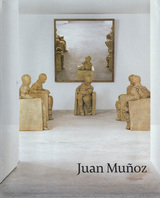 Juan Munoz
Neal Benezra and Olga M. Viso
University of Chicago Press, 2001 One of the leading artists of his generation, the Spanish sculptor Juan Muñoz (1953-2001) was known for his diverse and highly original body of work centering on the narrative possibilities of figures in environments. Juan Muñoz illustrates in full color approximately sixty works—including sculptures, drawings, and several major installations—which will be included in a major exhibition presented by the Hirshhorn Museum and Sculpture Garden and the Art Institute of Chicago in October 2001.
Muñoz's early work focused on architectural objects that implied a transitory human presence. Then, defying the trend among progressive artists, he began to introduce figures into his work. Casting his figures in papier-mâché, resin, and eventually bronze, Muñoz limited their size and descriptive details to heighten their psychological impact. In the 1990s, Muñoz created his signature "conversation pieces," large ensembles of figures installed in indoor or outdoor settings. Calling upon a wide range of sources in literature, music, film, as well as painting and sculpture, Muñoz's work explores the nature of psychological interaction and engages the viewer on a variety of perceptual levels.
Juan Muñoz includes essays by Neal Benezra, art critic Michael Brenson, and Olga Viso, as well as an interview with the artist by Paul Shimmel. Also featuring highlights from a 2001 installation commissioned by London's Tate Modern, Juan Muñoz is the most comprehensive overview of this challenging and exciting artist's work.
The Juan Pardo Expeditions: Exploration of the Carolinas and Tennessee, 1566-1568
Charles Hudson. Afterword by David G. Moore, Robin A. Beck Jr., and Christopher B. Rodning
University of Alabama Press, 2005 An early Spanish explorer’s account of American Indians. This volume mines the Pardo documents to reveal a wealth of information pertaining to Pardo’s routes, his encounters and interactions with native peoples, the social, hierarchical, and political structures of the Indians, and clues to the ethnic identities of Indians known previously only through archaeology. The new afterword reveals recent archaeological evidence of Pardo’s Fort San Juan--the earliest site of sustained interaction between Europeans and Indians--demonstrating the accuracy of Hudson’s route reconstructions.
Juan Peron and the Reshaping of Argentina
Frederick Turner
University of Pittsburgh Press, 1983 Although Juan Perón changed the course of modern Argentine history, scholars have often interpreted him in terms of their own ideologies and interests, rather than seeing the effect of this man and his movement had on the Argentine people. The essays in this volume seek to uncover the man behind the myth, to define the true nature of Perónism. Several chapters view Perón's rise to power, his deposition and eighteen-year exile, and his dramtic return in 1973. Others examine: opposing forces in modern Argentina, including the church and its role in politics; the conflict between landed stancieros and urban industrialists, terrorist activities and their popularist support base; Peronism and the labor movement; and Evita Perón's role in advancing the political rights of women.
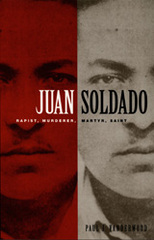 Juan Soldado: Rapist, Murderer, Martyr, Saint
Paul J. Vanderwood
Duke University Press, 2004 Paul J. Vanderwood offers a fascinating look at the events, beliefs, and circumstances that have motivated popular devotion to Juan Soldado, a Mexican folk saint. In his mortal incarnation, Juan Soldado was Juan Castillo Morales, a twenty-four-year-old soldier convicted of and quickly executed for the rape and murder of eight-year-old Olga Camacho in Tijuana in 1938. Immediately after Morales’s death, many people began to doubt the evidence of his guilt, or at least the justice of his brutal execution. People reported seeing blood seeping from his grave and hearing his soul cry out protesting his innocence. Soon the “martyred” Morales was known as Juan Soldado, or John the Soldier. Believing that those who have died unjustly sit closest to God, people began visiting Morales’s grave asking for favors. Within months of his death, the young soldier had become a popular saint. He is not recognized by the Catholic Church, yet thousands of people have made pilgrimages to his gravesite. While Juan Soldado is well known in Tijuana, southern California’s Mexican American community, and beyond, this book is the first to situate his story within a broader exploration of how and why popular canonizations such as his take root and flourish. In addition to conducting extensive archival research, Vanderwood interviewed central actors in the events of 1938, including Olga Camacho’s mother, citizens who rioted to demand Morales’s release to a lynch mob, those who witnessed his execution, and some of the earliest believers in his miraculous powers. Vanderwood also interviewed many present-day visitors to the shrine at Morales’s grave. He describes them, their petitions—for favors such as health, a good marriage, or safe passage into the United States—and how they reconcile their belief in Juan Soldado with their Catholicism. Vanderwood puts the events of 1938 within the context of Depression-era Tijuana and he locates people’s devotion, then and now, within the history of extra-institutional religious activity. In Juan Soldado, a gripping true-crime mystery opens up into a much larger and more elusive mystery of faith and belief.
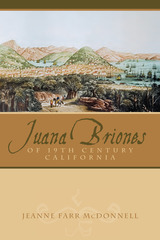 Juana Briones of Nineteenth-Century California
Jeanne Farr McDonnell
University of Arizona Press, 2008 Juana Briones de Miranda lived an unusual life, which is wonderfully recounted in this highly accessible biography. She was one of the first residents of what is now San Francisco, then named Yerba Buena (Good Herb), reportedly after a medicinal tea she concocted. She was among the few women in California of her time to own property in her own name, and she proved to be a skilled farmer, rancher, and businesswoman. In retelling her life story, Jeanne Farr McDonnell also retells the history of nineteenth-century California from the unique perspective of this surprising woman.
Juana Briones was born in 1802 and spent her early youth in Santa Cruz, a community of retired soldiers who had helped found Spanish California, Native Americans, and settlers from Mexico. In 1820, she married a cavalryman at the San Francisco Presidio, Apolinario Miranda. She raised her seven surviving sons and daughters and adopted an orphaned Native American girl. Drawing on knowledge she gained about herbal medicine and other cures from her family and Native Americans, she became a highly respected curandera, or healer.
Juana set up a second home and dairy at the base of then Loma Alta, now Telegraph Hill, the first house in that area. After gaining a church-sanctioned separation from her abusive husband, she expanded her farming and cattle business in 1844 by purchasing a 4,400-acre ranch, where she built her house, located in the present city of Palo Alto. She successfully managed her extensive business interests until her death in 1889. Juana Briones witnessed extraordinary changes during her lifetime. In this fascinating book, readers will see California’s history in a new and revelatory light.
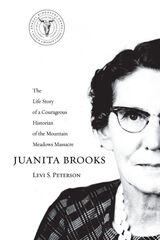 Juanita Brooks: The Life Story of a Courageous Historian of the Mountain Meadows Massacre
Levi S Peterson
University of Utah Press, 2011 Born in 1898 in Bunkerville, Nevada, Juanita Brooks led an early life similar to that of many who grew up in isolated, tightly knit, rural Mormon communities. An early marriage suggested her future would follow a predictable course, but the death of her husband, the need to raise a young son, and a passion for knowledge led her along a different path, when at mid-life she became a well-known author after publishing The Mountain Meadows Massacre. In this book she exposed the killing of some 100 California-bound emigrants traveling through southern Utah in 1856 as an atrocity carried out by a Mormon militia with Indian allies and not solely as an Indian massacre, as it had been for so long portrayed. Juanita Brooks was a faithful and active member of the Mormon Church, and her courage to tell the truth about this dark moment in Mormon history established her reputation as a respected historian. While there was no official church condemnation of the book, there was unofficial disapproval and Brooks was shunned by many in her community. She nevertheless doggedly pursued church authorities to revise their stand on the incidents at Mountain Meadows. The desire to tell the truth as she saw it became her hallmark, and Brooks’s life as wife, mother, teacher, community member, and undaunted historian became an uncommon story of personal stamina and intellectual courage.
Winner of the Evans Biography Award and the Mormon History Association Best Book Award.
Juanita la Larga: a Novel
Juan Valera
Catholic University of America Press, 2006 Juanita la Larga (1896), the third of Juan Valera's eponymous novels with a female protagonist, unfolds in a small town in nineteenth-century Spain and tells the story of a young girl's romance with a wealthy widower many years her senior.
Juarez
Edited, with an introduction by Paul J. Vanderwood; Tino T. Balio, Series Editor
University of Wisconsin Press, 1983 Juárez was Warner Brothers' cinematic attempt to answer the major international question of the 1930s: would democracy or dictatorship prevail? Eager to further the foreign policy objectives of its friend Franklin Delano Roosevelt and equally willing to add to its prestigious and profitable biography series, the stuido set a record high budget and assembled special film stock, extensive scholarly research, a loose time schedule, a renowned director, and a stellar cast that included Paul Muni, Brian Aherne, and Bette Davis. The film was meant to be an ideologically clear-cut statement against fascism. The ways in which this artistic propaganda backfired make Juárez a significant historical document for students of film, Latin American history, and U.S. foreign relations.
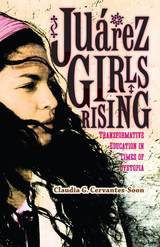 Juárez Girls Rising: Transformative Education in Times of Dystopia
Claudia G. Cervantes-Soon
University of Minnesota Press, 2017 Working-class girls in Ciudad Juárez grow up in a context marked by violence against women, the devastating effects of drug cartel wars, unresponsive and abusive authorities, and predatory U.S. capitalism: under constantly precarious conditions, these girls are often struggling to shape their lives and realize their aspirations. Juárez native Claudia G. Cervantes-Soon explores the vital role that transformative secondary education can play in promoting self-empowerment and a spirit of resistance to the violence and social injustice these girls encounter. Bringing together the voices of ten female students at Preparatoria Altavista, an innovative urban high school founded in 1968 on social justice principles, Cervantes-Soon offers a nuanced analysis of how students and their teachers together enact a transformative educational philosophy that promotes learning, self-authorship, and hope. Altavista’s curriculum is guided by the concept of autogestión, a holistic and dialectical approach to individual and collective identity formation rooted in the students’ experiences and a critical understanding of their social realities. Through its sensitive ethnography, this book shows how female students actively construct their own meaning of autogestión by making choices that they consider liberating and empowering. Juárez Girls Rising provides an alternative narrative to popular and often simplistic, sensationalizing, and stigmatizing discourses about those living in this urban borderland. By merging the story of Preparatoria Altavista with the voices of its students, this singular book provides a window into the possibilities and complexities of coming of age during a dystopic era in which youth hold on to their critical hope and cultivate their wisdom even as the options for the future appear to crumble before their eyes.
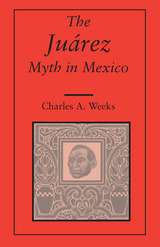 The Juarez Myth In Mexico
Charles A. Weeks
University of Alabama Press, 1987 The embodiment of a myth—Benito Juarez
Like many capitals the city of Mexico is a place of monuments-large monuments, small, ancient monuments, and new, representational monuments, and allegorical monuments—each bearing a message from the past. Among them is the Hemiciclo. It stands in a spacious, old, beautiful park, the Alameda Central, where the young and old of the city still promenade on Sundays and holidays as people do in the plazas throughout the country and, indeed, as people do in many parts of the world. Amid green trees and a great variety of flowers and shrubs and flanked by a semicircle of twelve doric columns of white Carrara marble stands the central pedestal of the Hemiciclo supporting the statues of three figures. One statue represents a former president of the republic, Benito Juarez, who appears solemn and grim as a Roman proconsul administering justice. Juarez the Lawgiver is seated, and surrounding him are two allegorical figures, also of marble, one representing Glory, who is placing a crown on Juarez’s head, and the other, the Republic, who stands behind, resting her sword on the ground to signify the end of a gigantic struggle. The letters of the pedestal read: “Al Benemerito Benito Juarez. La Patria.” Many years have passed since 1910, when the Mexican government built and dedicated the Hemiciclo after a design by the architect Guillermo Heredia.
Like many other such monuments it is the embodiment of a myth. In life Juarez offered little to the mythologizers-he was never able to boast a military career, he often impressed people as reserved or even impassive. he stood a little over five feet; with small hands and feet and dark staring eyes, a coppery complexion that helped disguise a large scar across his face, of Zapotec Indian parentage, he was no striking figure. He did, however, lead Mexican liberals in the I 850s and 1860s in their titanic struggle against formidable opposition, both foreign and domestic, and in the years since his death his worshipers have gathered at the Hemiciclo, at his tomb, or in many other places in Mexico sacred to his memory, usually on anniversaries of his birth or death. For them Juarez is, in agreement with the golden inscription on the central pedestal of the Hemiciclo, “Benemerito de la Patria” or even “Benemerito de las Americas.”
Development of a Juarez myth has had all the classic characteristics of myths and mythmaking, especially the subjective view or image of a reality, whether it be of an historical figure, as in the case of Juarez, an event, an institution, or even a geographical region. Image or meaning ascribed to what is assumed to be a reality constitutes one of the main elements of myth and when manipulated to promote a cause assumes a reality of its own. The apotheosis of Juarez projected a subjective view or image of the historical reality. In all myths, to be sure, the assumed reality is a feature useful to an individual or a group.
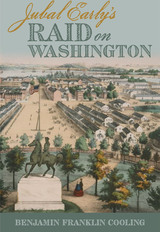 Jubal Early's Raid on Washington
Benjamin Franklin Cooling
University of Alabama Press, 2008 The definitive description of the last Confederate invasion of the Union in 1864. The Civil War was in its fourth year, and the Union’s victory was not at all certain. The Lincoln administration seemed weak as the autumn election approached. Lee’s army remained strong in Virginia while Johnston’s forces feinted and dodged in north Georgia to shield Atlanta. The Union army and navy grew in strength, but Confederate forces continued to fight tenaciously.
Amid an air of stalemate, the Confederates planned a bold move to strike at Washington, DC and capture or scatter Lincoln and his cabinet. In command of the operation was the colorful and unpredictable Jubal “Old Jube” Anderson Early, brought in to replace the fallen Stonewall Jackson. Less well known than the bloodier Antietam and Gettysburg, Early's campaign, Cooling argues, had greater significance.
In addition to the persnickety bachelor Anderson, this account introduces many colorful participants, including railroad president John W. Garrett, the politically influential Blair family, and Elizabeth “Aunt Betty” Thomas, a free Black woman, who was said to have saved Lincoln’s life by shouting at him: “Get down, you fool!” when he came under fire at Fort Stevens. Exciting and comprehensive, Civil War scholars and readers will delight in this masterful account.
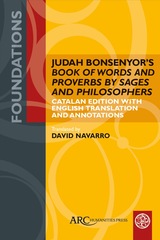 Judah Bonsenyor’s "Book of Words and Proverbs by Sages and Philosophers": Catalan Edition with English Translation and Annotations
David Navarro
Arc Humanities Press, 2025 This book presents the first annotated English translation of Judah Bonsenyor’s Book of Words and Proverbs by Sages and Philosophers (ca. 1294), a seminal work within the medieval Catalan sapiential tradition. Compiled at the request of King James II of Aragon, the book gathers proverbs of Arabic, Hebrew, and Eastern traditions which bring together a didactic purpose from wisdom and personal experience that has not lost its value to this day. The text was widely disseminated during the late Middle Ages from the eight Catalan manuscripts that have been preserved as well as from an early fifteenth-century Spanish translation. This side-by-side annotated medieval Catalan to English translation is an essential resource for anybody interested in the proverbial genre from medieval Catalonia but not fluent in the language or trained in the gnomic literature field.
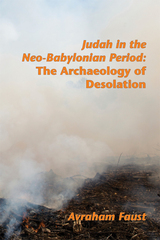 Judah in the Neo-Babylonian Period: The Archaeology of Desolation
Avraham Faust
SBL Press, 2012 The Babylonian conquest of Jerusalem in 586 B.C.E. was a watershed event in the history of Judah, the end of the monarchy and the beginning of the exilic period, during which many of the biblical texts were probably written. The conquest left clear archaeological marks on many sites in Judah, including Jerusalem, and the Bible records it as a traumatic event for the population. Less clear is the situation in Judah following the conquest, that is, in the sixth century, a period with archaeological remains the nature and significance of which are disputed. The traditional view is that the land was decimated and the population devastated. In the last two decades, archaeologists arguing that the land was not empty and that the exile had little impact on Judah’s rural sector have challenged this view. This volume examines the archaeological reality of Judah in the sixth century in order to shed new light on the debate. By expanding research into new avenues and examining new data, as well as by applying new methods to older data, the author arrives at fresh insights that support the traditional view of sixth-century Judah as a land whose population, both urban and rural, was devastated and whose recovery took centuries.
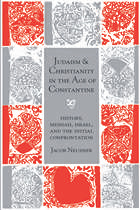 Judaism and Christianity in the Age of Constantine: History, Messiah, Israel, and the Initial Confrontation
Jacob Neusner
University of Chicago Press, 1987 With the conversion of Constantine in 312, Christianity began a period of political and cultural dominance that it would enjoy until the twentieth century. Jacob Neusner contradicts the prevailing view that following Christianity's ascendancy, Judaism continued to evolve in isolation. He argues that because of the political need to defend its claims to religious authenticity, Judaism was forced to review itself in the context of a triumphant Christianity. The definition of issues long discussed in Judaism—the meaning of history, the coming of the Messiah, and the political identity of Israel—became of immediate and urgent concern to both parties. What emerged was a polemical dialogue between Christian and Jewish teachers that was unprecedented.
In a close analysis of texts by the Christian theologians Eusebius, Aphrahat, and Chrysostom on one hand, and of the central Jewish works the Talmud of the Land of Israel, the Genesis Rabbah, and the Leviticus Rabbah on the other, Neusner finds that both religious groups turned to the same corpus of Hebrew scripture to examine the same fundamental issues. Eusebius and Genesis Rabbah both address the issue of history, Chrysostom and the Talmud the issue of the Messiah, and Aphrahat and Leviticus Rabbah the issue of Israel. As Neusner demonstrates, the conclusions drawn shaped the dialogue between the two religions for the rest of their shared history in the West.
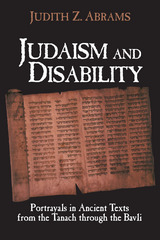 Judaism and Disability: Portrayals in Ancient Texts from the Tanach through the Bavli
Judith Z. Abrams
Gallaudet University Press, 1998 The Jewish religion owns a virtually uninterrupted record of scripture and commentary dating back to 1,000 B.C.E. (B.C.), portions of which allow the new book Judaism and Disability: Portrayals in Ancient Texts from the Tanach through the Bavli to document attitudes toward disabled people in the earliest centuries of this ancient culture. Abrams examines the Tanach, the Hebrew acronym for the Jewish Bible, including passages from the Torah, Prophets, and Writings, and subsequent commentaries up to and through the Bavli, the Talmud of Babylonia written between the 5th and 7th centuries C.E. (A.D.).
In Judaism and Disability, the archaic portrayals of mentally ill, mentally retarded, physically affected, deaf, blind, and other disabled people reflect the sharp contrast they presented compared to the unchanging Judaic ideal of the “perfect priest.” All of these sources describe this perfection as embodied in a person who is male, free, unblemished, with da’at (cognition that can be communicated), preferably learned, and a priest. The failure to have da’at stigmatized disabled individuals, who were also compromised by the treatment they received from nondisabled people, who were directing and constraining.
As the Judaic ideal transformed from the bodily perfection of the priest in the cult to intellectual prowess in the Diaspora, a parallel change of attitudes toward disabled persons gradually occurred. The reduced emphasis upon physical perfection as a prerequisite for a relationship with God eventually enabled the enfranchisement of some disabled people and other minorities. Scholars, students, and other readers will find the engrossing process disclosed in Judaism and Disability one that they can apply to a variety of other disciplines.
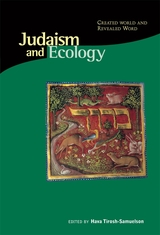 Judaism and Ecology: Created World and Revealed Word
Hava Tirosh-Samuelson
Harvard University Press, 2002 Jewish ecological discourse has shown that Judaism harbors deep concern for the well-being of the natural world. However, the movement has not articulated a Jewish theology of nature, nor has it submitted the sources of Judaism to a systematic, philosophical examination.
This volume intends to contribute to the nascent discourse on Judaism and ecology by clarifying diverse conceptions of nature in Jewish thought and by using the insights of Judaism to formulate a constructive Jewish theology of nature. The twenty-one contributors consider the Bible and rabbinic literature, examine the relationship between the doctrine of creation and the doctrine of revelation in the context of natural law, and wrestle with questions of nature and morality. They look at nature in the Jewish mystical tradition, and they face the challenges to Jewish environmental activism caused by the tension between the secular nature of the environmental discourse and Jewish religious commitments.
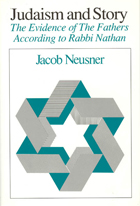 Judaism and Story: The Evidence of The Fathers According to Rabbi Nathan
Jacob Neusner
University of Chicago Press, 1992 In this close analysis of The Fathers According to Rabbi Nathan, a sixth-century commentary on the Mishnah-tractate The Fathers (Avot), Jacob Neusner considers the way in which the story, as a distinctive type of narrative, entered the canonical writings of Judaism. The final installment in Neusner's cycle of analyses of the major texts of the Judaic canon, Judaism and Story shows that stories about sages exist in far greater proportion in The Fathers According to Rabbi Nathan than in any of the other principal writings in the canon of Judaism of late antiquity. Neusner's detailed comparison of The Fathers and The Fathers According to Rabbi Nathan demonstrates the transmission and elaboration of these stories and shows how these processes incorporated the newer view of the sage as a supernatural figure and of the eschatological character of Judaic teleology. These distinctions, as Neusner describes them, mark a shift in Jewish orientation to world history.
Judaism and Story documents a chapter of rabbinic tradition that explored the possibility of historical orientation by means of stories. As Neusner demonstrates, this experiment with narrative went beyond the borders of rabbinic preoccupation with rhetorical argumentation focused on the explication of the Torah. The sage story moved in the direction of biography, but without allowing biography to emerge. This development, in Neusner's account, parallels the movement from epistle to Gospel in early Christianity and thus has broad implications for the history of religions.
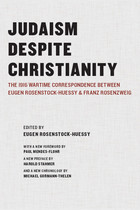 Judaism Despite Christianity: The 1916 Wartime Correspondence Between Eugen Rosenstock-Huessy and Franz Rosenzweig
Edited by Eugen Rosenstock-Huessy
University of Chicago Press, 2011 Before they were both internationally renowned philosophers, Eugen Rosenstock-Huessy and Franz Rosenzweig were young German soldiers fighting in World War I corresponding by letter and forming the foundation of their deep intellectual friendship. Collected here, this correspondence provides an intimate portrait of their views on history, philosophy, rhetoric, and religion as well as on their writings and professors. Most centrally, Rosenstock-Huessy and Rosenzweig discuss, frankly but respectfully, the differences between Judaism and Chiristianity and the reasons they have chosen their respective faiths. This edition includes a new foreword by Paul Mendes-Flohr, a new preface by Harold Stahmer along with his original introduction, and essays by Dorothy Emmet and Alexander Altmann, who calls this correspondence “one of the most important religious documents of our age” and “the most perfect example of a human approach to the Jewish-Christian problem.”
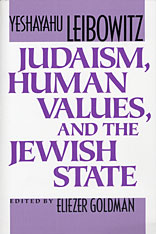 Judaism, Human Values, and the Jewish State
Yeshayahu Leibowitz
Harvard University Press, 1995 A biochemist by profession, a polymath by inclination and erudition, Yeshayahu Leibowitz has been, since the early 1940s, one of the most incisive and controversial critics of Israeli culture and politics. His direct involvement, compelling polemics, and trenchant criticism have established his steadfast significance for contemporary Israeli—and Jewish—intellectual life. These hard-hitting essays, his first to be published in English, cover the ground Leibowitz has marked out over time with moral rigor and political insight. He considers the essence and character of historical Judaism, the problems of contemporary Judaism and Jewishness, the relationship of Judaism to Christianity, the questions of statehood, religion, and politics in Israel, and the role of women. Together these essays constitute a comprehensive critique of Israeli society and politics and a probing diagnosis of the malaise that afflicts contemporary Jewish culture.
Leibowitz’s understanding of Jewish philosophy is acute, and he brings it to bear on current issues. He argues that the Law, Halakhah, is essential to Judaism, and shows how, at present, separation of religion from state would serve the interest of halakhic observance and foster esteem for religion. Leibowitz calls the religious justification of national issues “idolatry” and finds this phenomenon at the root of many of the annexationist moves made by the state of Israel. Long one of the most outspoken critics of Israeli occupation in the conquered territories, he gives eloquent voice to his ongoing concern over the debilitating moral effects of its policies and practices on Israel itself. This translation will bring to an English-speaking audience a much-needed, lucid perspective on the present and future state of Jewish culture.
Judaism in South India, 849–1489: Relocating Malabar Jewry
Ophira Gamliel
Arc Humanities Press, 2023 Jewish presence in Malabar (also known as Kerala) is attested since the ninth century in various sources and diverse languages. Malabar Jewry emerged out of the medieval Indian Ocean maritime trade networks and in the context of intense inter-cultural contacts between West and South Asia. This book ventures to contextualize Malabar Jewish history in long-distance trade networks and their transition from the medieval Arab maritime trade (900s-1500s).
Judaism in the First Centuries of the Christian Era: The Age of the Tannaim
George Foot Moore
Harvard University Press In this volume Professor Moore presents a series of Notes supplementary to the text of his two volumes on Judaism published in 1927. Some of the entries consist of emendations of the text; others summarize the views of scholars who differ from the author on various disputed points. The list of “longer notes and discussion” includes such topics as “Great Synagogue,” “Chronology of the Post-Exilic Period,” “Continuity of Normative Judaism,” “Sanhedrin,” “Paul," “Ground of Obligation in Revealed Religion.”
 Judaism in the First Centuries of the Christian Era: The Age of the Tannaim
George Foot Moore
Harvard University Press In these volumes George Moore has aimed at presenting Judaism as it was in the centuries during which it assumed definitive form, according to the tradition it has always held authentic. The Introduction sketches the external and internal history of those centuries, so far as that history affected religion, and summarizes the sources on which the account is based. In the chapters on Revealed Religion he explains the basic principles of Judaism and discusses the methods of its application. On those chapters as a logical base, he erects a superstructure made up of illuminating studies of the Idea of God, the Nature of Man and his Relation to God, the Observances of Religion, Morals, Piety, and the Hereafter. Moore, universally known as a distinguished scholar in these subjects, has spent ten years in the composition of his book, which contains the exhaustive information and ripe conclusions resulting from more than thirty years of wide reading and concentrated thought. Primarily for the scholars who have been impatiently awaiting it, the book is arranged so logically, written so simply and clearly, and is so intrinsically arresting in its subject-matter that no thoughtful reader can fail to be deeply interested by it.
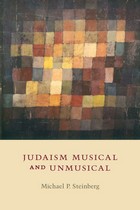 Judaism Musical and Unmusical
Michael P. Steinberg
University of Chicago Press, 2008 Modernity gave rise to a Jewish consciousness that has increasingly distanced itself from the sacred in favor of worldliness and secularity. Judaism Musical and Unmusical traces the formulation of this secular Jewishness from its Enlightenment roots through the twentieth century to explore the infinite variations of modern Jewish experience in Central Europe and beyond.
Engaging the work of such figures as Sigmund Freud, Walter Benjamin, Hannah Arendt, Charlotte Salomon, Arnaldo Momigliano, Leonard Bernstein, and Daniel Libeskind, Michael Steinberg shows how modern Jews advanced cosmopolitanism and multiplicity by helping to loosen—whether by choice or by necessity—the ties that bind any culture to accounts of its origins. In the process, Steinberg composes a mosaic of texts and events, often distant from one another in time and place, that speak to his theme of musicality. As both a literal value and a metaphorical one, musicality opens the possibility of a fusion of aesthetics and analysis—a coupling analogous to European modernity’s twin concerns of art and politics.
Judaism: The Genealogy of a Modern Notion
Boyarin, Daniel
Rutgers University Press, 2019 Judaism makes the bold argument that the very concept of a religion of ‘Judaism’ is an invention of the Christian church. The intellectual journey of world-renowned Talmud scholar Daniel Boyarin, this book will change the study of “Judaism”—an essential key word in Jewish Studies—as we understand it today. Boyarin argues that although the world treats the word “Judaism” as appropriate for naming an alleged religion of the Jews, it is in fact a Christian theological concept only adopted by Jews with the coming of modernity and the adoption of Christian languages.
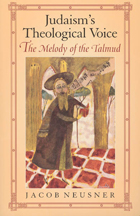 Judaism's Theological Voice: The Melody of the Talmud
Jacob Neusner
University of Chicago Press, 1995 Distinguished historian of Judaism Jacob Neusner here ventures for the first time into constructive theology. Taking the everyday life of contemporary Judaism as his beginning, Neusner asks when in the life of the living faith of the Torah does Israel, the holy community, meet God? Where does the meeting take place? What is the medium of the encounter?
In his attempt to answer these questions, Neusner sets forth the character and the form of the Torah as sung theology. Israel, the holy community, meets God in the synagogue, while at prayer, and in the yeshiva, when studying the Torah—at the moment in each setting when the Torah is received. In both circumstances people do not read but sing out its words. With the written part of the Torah sung in the synagogue, and the oral part declaimed in centers of sacred learning, music provides the medium for Judaism's theological voice.
Neusner identifies a reciprocal exchange between the holy community Israel and God: Israel sings to God when the Torah is studied, and God sings to Israel when the Torah is declaimed. Through the metaphor of music, Neusner offers an account of how he believes those faithful to the Torah meet God in the Torah, and how they should listen to the melody of God's self-revelation. The result is an original theological reflection that will interest all students of Judaism.
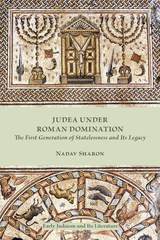 Judea under Roman Domination: The First Generation of Statelessness and Its Legacy
Nadav Sharon
SBL Press, 2017 Investigate a relatively neglected but momentous period in Judean history
Nadav Sharon closely examines a critical period in Judean history, which saw the end of the Hasmonean dynasty and the beginning of Roman domination of Judea leading up to the kingship of Herod (67-37 BCE). In this period renowned Roman figures such as Pompey the Great, Julius Caesar, Gaius Cassius (a conspirator against Caesar), and Mark Anthony, led the Roman Republic on the eve of its transformation into an Empire, each having his own dealings with—and holding sway over—Judea at different times. This volume explores the impact of the Roman conquest on the authors of the Dead Sea Scrolls, enhances the understanding of later Judean-Roman relations and the roots of the Great Revolt, and examines how this early period of Roman domination had on impact on later developments in Judean society and religion.
Features:
- Part one dedicating to reconstructing Judean history from the death of Alexander to the reign of King Herod
- Part two examining the effects of Roman domination on Judean society
- Maps, illustrations, and appendices
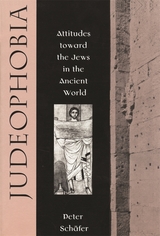 Judeophobia: Attitudes toward the Jews in the Ancient World
Peter Schäfer
Harvard University Press, 1997 Taking a fresh look at what the Greeks and Romans thought about Jews and Judaism, Peter Schäfer locates the origin of anti-Semitism in the ancient world. Judeophobia firmly establishes Hellenistic Egypt as the generating source of anti-Semitism, with roots extending back into Egypt’s pre-Hellenistic history.
A pattern of ingrained hostility toward an alien culture emerges when Schäfer surveys an illuminating spectrum of comments on Jews and their religion in Greek and Roman writings, focusing on the topics that most interested the pagan classical world: the exodus or, as it was widely interpreted, expulsion from Egypt; the nature of the Jewish god; food restrictions, in particular abstinence from pork; laws relating to the sabbath; the practice of circumcision; and Jewish proselytism. He then probes key incidents, two fierce outbursts of hostility in Egypt: the destruction of a Jewish temple in Elephantine in 410 B.C.E. and the riots in Alexandria in 38 C.E. Asking what fueled these attacks on Jewish communities, the author discovers deep-seated ethnic resentments. It was from Egypt that hatred of Jews, based on allegations of impiety, xenophobia, and misanthropy, was transported first to Syria-Palestine and then to Rome, where it acquired a new element: fear of this small but distinctive community. To the hatred and fear, ingredients of Christian theology were soon added—a mix all too familiar in Western history.
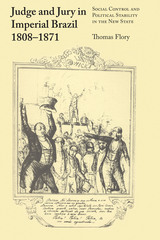 Judge and Jury in Imperial Brazil, 1808–1871: Social Control and Political Stability in the New State
By Thomas Flory
University of Texas Press, 1981 In nineteenth-century Brazil the power of the courts rivaled that of the central government, bringing to it during its first half century of independence a stability unique in Latin America. Thomas Flory analyzes the Brazilian lower-court system, where the private interests of society and the public interests of the state intersected. Justices of the peace—lay judges elected at the parish level—played a special role in the early years of independence, for the post represented the triumph of Brazilian liberalism’s commitment to localism and decentralization. However, as Flory shows by tracing the social history and performance of parish judges, the institution actually intensified conflict within parishes to the point of destabilizing the local regime and proved to be so independent of national interests that it all but destroyed the state. By the 1840s the powers of the office were passed to state appointees, particularly the district judges. Flory recognizes these professional magistrates as a new elite who served as brokers between the state and the poorly articulated landowner elite, and his account of their rise reveals the mechanisms of state integration. In focusing on the judiciary, Flory has isolated a crucial aspect of Brazil’s early history, one with broad implications for the study of nineteenth-century Latin America as a whole. He combines social, intellectual, and political perspectives—as well as national-level discussion with scrutiny of parish-level implementation—and so makes sense of a complicated, little-studied period. The study clearly shows the progression of Brazilian social thought from a serene liberal faith in the people as a nation to an abiding, very modern distrust of that nation as a threat to the state.
Judge Dee at Work: Eight Chinese Detective Stories
Robert van Gulik
University of Chicago Press, 1992 A delectable collection of cozy puzzle mysteries starring the wonderful Chinese sleuth Judge Dee, whom the Los Angeles Times ranked with Sherlock Holmes
The eight short stories in Judge Dee at Work cover a decade during which the judge served in four different provinces of the T’ang Empire. From the suspected treason of a general in the Chinese army to the murder of a lonely poet in his garden pavilion, the cases here are among the most memorable in the Judge Dee series.
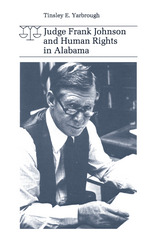 Judge Frank Johnson and Human Rights in Alabama
Tinsley E. Yarbrough
University of Alabama Press, 1981 Judge Frank M. Johnson, Jr., Chief Judge of the United States District Court for the Middle District of Alabama until his elevation to the Court of Appeals for the Fifth Circuit in 1979, was perhaps President Dwight D. Eisenhower’s most significant appointment to a lower court. His selection to the bench in 1955 followed by only a few months the Supreme Court’s historic decision in Brown vs. Board of Education. During Judge Johnson’s tenure, his court invalidated segregation and other forms of racial discrimination in Alabama’s transportation facilities, voter registration processes, school and colleges, administrative agencies, system of jury selection, prisons, mental institutions, political parties, and government grant programs. In fact, most of the state’s major racial crises were resolved in his courtroom. However, his impact on human rights policy in Alabama was not confined to a racial context. Among other significant developments, the Middle District Court ordered reapportionment of the state’s governing bodies and invalidated its grossly inequitable property tax systems. Judge Johnson’s decisions made him one of the most widely respected and controversial trial judges in the country. Until recently, however, his name was anathema to many white Alabamians, and he and his family were subject to ostracism, threats, violence, and verbal abuse. Yarbrough examines Judge Johnson’s life through the end of the Wallace era and the Judge’s appointment to the Fifth Circuit Court. More broadly, the book is a history of modern human rights reform in Alabama, cast in the biographical idiom. For, in a real sense, the history of the reform and of Judge Johnson’s judicial career have been synonymous.
 Judges and the Cities: Interpreting Local Autonomy
Gordon L. Clark
University of Chicago Press, 1985 In this remarkable inquiry into the bases of social theory, Gordon L. Clark argues that the heterogeneous nature of our society, with its pluralism of values, causes the rules of social conduct to be constantly made and remade. Examining the role of the courts in structuring and achieving social discourse, he contends that legal doctrine is no different from other social theories: judicial interpretations are constructed out of specific circumstances and conflicting values, not deduced from neutral and logical principles. There is, he asserts, no final arbiter somehow unaffected by our controversies and schisms.
As concrete examples, Clark analyzes four court disputes in depth, showing that the concept of local autonomy has very different meanings and implications in each of them. These cases—Boston's defense of resident-preference hiring policies, conflict over urban land-use zoning in Toronto, a Chicago's suburb's fight against a sewage treatment plant, and the evolution of the City of Denver's power since 1900—demonstrate that legal reasoning is not impervious to other kinds of reasoning, and the solutions provided by the courts are not unique. To ground his explorations, Clark investigates both liberalism and structuralism, showing that both are inadequate bases for determining social policy. He mounts provocative critiques of the works of de Tocqueville, Nozick, Tiebout, and Posner on the one hand and Castells and Poulantzas on the other.
This ambitious and important work will command the interest of geographers, political scientists, economists, sociologists, and legal scholars.
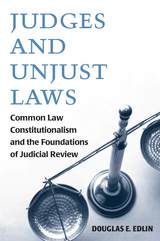 Judges and Unjust Laws: Common Law Constitutionalism and the Foundations of Judicial Review
Douglas E. Edlin
University of Michigan Press, 2010 "With keen insight into the common law mind, Edlin argues that there are rich resources within the law for judges to ground their opposition to morally outrageous laws, and a legal obligation on them to overturn it, consequent on the general common law obligation to develop the law. Thus, seriously unjust laws pose for common law judges a dilemma within the law, not just a moral challenge to the law, a conflict of obligations, not just a crisis of conscience. While rooted firmly in the history of common law jurisprudence, Edlin offers an entirely fresh perspective on an age-old jurisprudential conundrum. Edlin's case for his thesis is compelling."
---Gerald J. Postema, Cary C. Boshamer Professor of Philosophy and Professor of Law, University of North Carolina at Chapel Hill, and author of Bentham and the Common Law Tradition "Douglas Edlin builds a powerful historical, conceptual, and moral case for the proposition that judges on common law grounds should refuse to enforce unjust legislation. This is sure to be controversial in an age in which critics already excoriate judges for excessive activism when conducting constitutional judicial review. Edlin's challenge to conventional views is bold and compelling."
---Brian Z. Tamanaha, Chief Judge Benjamin N. Cardozo Professor of Law, St. John's University, and author of Law as a Means to an End: Threat to the Rule of Law "Professor Edlin's fascinating and well-researched distinction between constitutional review and common law review should influence substantially both scholarship on the history of judicial power in the United States and contemporary jurisprudential debates on the appropriate use of that power."
---Mark Graber, Professor of Law and Government, University of Maryland, and author of Dred Scott and the Problem of Constitutional Evil Is a judge legally obligated to enforce an unjust law? In Judges and Unjust Laws, Douglas E. Edlin uses case law analysis, legal theory, constitutional history, and political philosophy to examine the power of judicial review in the common law tradition. He finds that common law tradition gives judges a dual mandate: to apply the law and to develop it. There is no conflict between their official duty and their moral responsibility. Consequently, judges have the authority---perhaps even the obligation---to refuse to enforce laws that they determine unjust. As Edlin demonstrates, exploring the problems posed by unjust laws helps to illuminate the institutional role and responsibilities of common law judges. Douglas E. Edlin is Associate Professor of Political Science at Dickinson College.
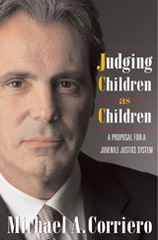 Judging Children As Children: A Proposal for a Juvenile Justice System
Michael A. Corriero
Temple University Press, 2007 At a time when America's court system increasingly tries juvenile offenders as adults, Michael Corriero draws directly from his experience as the founding judge of a special juvenile court to propose a new approach to dealing with youthful offenders. Since 1992, Judge Corriero has presided over the Manhattan Youth Part, a New York City court specifically designed to discipline teenage offenders. Its guiding principles, clearly laid out in this book, are that children are developmentally different from adults and that a judge can be a formidable force in shaping the lives of children who appear in court. Judging Children as Children makes a compelling argument for a better system of justice that recognizes the mental, emotional, and physical abilities of young people and provides them with an opportunity to be rehabilitated as productive members of society instead of being locked up in prisons.
 Judging Credentials: Nonlawyer Judges and the Politics of Professionalism
Doris Marie Provine
University of Chicago Press, 1986 Must judges be trained as lawyers in order to be effective in office, or can nonlawyers serve equally well? This question has long provoked controversy among lawyers, judges, legislators, and the public. In her empirical study of the place of the nonlawyer judge in the American legal system, Doris Marie Provine concludes that, despite the opposition of the legal profession to nonlawyer judges, they are as competent as lawyers in carrying out judicial duties in courts of limited jurisdiction.
Provine presents a persuasive argument that the case against nonlawyer judges has been weighted in favor of the professional interests of lawyers, not public concerns. Her examination reveals as much about the presuppositions of legal professionals as it does about the competency of nonlawyer judges to old judicial office. To substantiate her claims, Provine has conducted the most comprehensive survey of nonlawyer and lawyer judges yet undertaken, augmenting this material with court observations and extensive interviews of judges. She integrates the results of this survey into the historical context of the lay versus lawyer judge debate, showing how the legally trained judge came to predominate in the American judicial system and analyzing in detail the campaign both in and out of the courts to make legal training a prerequisite for being a judge. Ultimately, Provine suggests, Americans are too committed to the significance of credentials and to the legal profession's vision of the judicial process to respond very favorably to nonlawyer judges, however well they might perform.
Judging Credentials will force lawyers, judges, scholars, and the public to reconsider the role nonlawyer judges play in the American judicial system. Provine's provocative views and exhaustive research adds new dimensions to our understanding of the ethics of professionalism and its consequences.
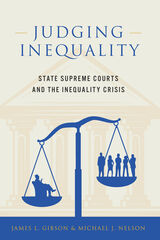 Judging Inequality: State Supreme Courts and the Inequality Crisis
James L. Gibson
Russell Sage Foundation, 2021 Social scientists have convincingly documented soaring levels of political, legal, economic, and social inequality in the United States. Missing from this picture of rampant inequality, however, is any attention to the significant role of state law and courts in establishing policies that either ameliorate or exacerbate inequality. In Judging Inequality, political scientists James L. Gibson and Michael J. Nelson demonstrate the influential role of the fifty state supreme courts in shaping the widespread inequalities that define America today, focusing on court-made public policy on issues ranging from educational equity and adequacy to LGBT rights to access to justice to worker’s rights.
Drawing on an analysis of an original database of nearly 6,000 decisions made by over 900 judges on 50 state supreme courts over a quarter century, Judging Inequality documents two ways that state high courts have crafted policies relevant to inequality: through substantive policy decisions that fail to advance equality and by rulings favoring more privileged litigants (typically known as “upperdogs”). The authors discover that whether court-sanctioned policies lead to greater or lesser inequality depends on the ideologies of the justices serving on these high benches, the policy preferences of their constituents (the people of their state), and the institutional structures that determine who becomes a judge as well as who decides whether those individuals remain in office.
Gibson and Nelson decisively reject the conventional theory that state supreme courts tend to protect underdog litigants from the wrath of majorities. Instead, the authors demonstrate that the ideological compositions of state supreme courts most often mirror the dominant political coalition in their state at a given point in time. As a result, state supreme courts are unlikely to stand as an independent force against the rise of inequality in the United States, instead making decisions compatible with the preferences of political elites already in power. At least at the state high court level, the myth of judicial independence truly is a myth.
Judging Inequality offers a comprehensive examination of the powerful role that state supreme courts play in shaping public policies pertinent to inequality. This volume is a landmark contribution to scholarly work on the intersection of American jurisprudence and inequality, one that essentially rewrites the “conventional wisdom” on the role of courts in America’s democracy.
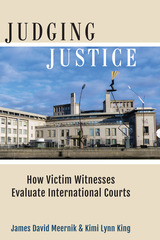 Judging Justice: How Victim Witnesses Evaluate International Courts
James David Meernik and Kimi Lynn King
University of Michigan Press, 2019 Some injustices are so massive, so heinous, and so extraordinary that ordinary courts are no longer adequate. The creation of international courts and tribunals to confront major violations of human rights sought to bring justice to affected communities as well as to the entire world. Yet if justice is a righting of the imbalance between what has happened and what is reflected in the law, no amount of punishment and no judgment could compensate for that suffering and loss.
In order to understand the meaning of justice, James David Meernik and Kimi Lynn King studied the perspective of witnesses who have testified before the International Criminal Tribunal for the Former Yugoslavia (ICTY). Using a unique survey, Meernik and King look at the identity of the victims and their perception of the fairness of ICTY. Because of the need to justify the practical and emotional difficulties involved in testifying before an international tribunal, witnesses look not just to the institution to judge its effectiveness, but also to their own contribution, by testifying effectively. The central elements of the theory Meernik and King develop—identity, fairness, and experience—transcend specific conflicts and specific countries and are of importance to people everywhere.
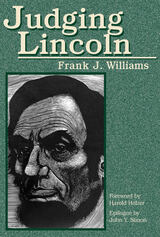 Judging Lincoln
Frank J. Williams. Foreword by Harold Holzer. Epilogue by John Y. Simon
Southern Illinois University Press, 2007 Judging Lincoln collects nine of the most insightful essays on the topic of the sixteenth president written by Frank J. Williams, chief justice of the Rhode Island Supreme Court and one of the nation’s leading authorities on Abraham Lincoln. For Judge Williams, Lincoln remains the central figure of the American experience—past, present, and future.
Williams begins with a survey of the interest in—and influence of—Lincoln both at home and abroad and then moves into an analysis of Lincoln’s personal character with respect to his ability to foster relationships of equality among his intimates. Williams then addresses Lincoln’s leadership abilities during the span of his career, with particular emphasis on the Civil War. Next, he compares the qualities of Abraham Lincoln, Franklin Delano Roosevelt, and Winston Churchill. The final essay, cowritten with Mark E. Neely Jr., concerns collecting Lincoln artifacts as a means of preserving and fostering the Lincoln legacy.
 Judging School Discipline: The Crisis of Moral Authority
Richard Arum
Harvard University Press, 2005 Reprimand a class comic, restrain a bully, dismiss a student for brazen attire--and you may be facing a lawsuit, costly regardless of the result. This reality for today's teachers and administrators has made the issue of school discipline more difficult than ever before--and public education thus more precarious. This is the troubling message delivered in Judging School Discipline, a powerfully reasoned account of how decades of mostly well-intended litigation have eroded the moral authority of teachers and principals and degraded the quality of American education.
Judging School Discipline casts a backward glance at the roots of this dilemma to show how a laudable concern for civil liberties forty years ago has resulted in oppressive abnegation of adult responsibility now. In a rigorous analysis enriched by vivid descriptions of individual cases, the book explores 1,200 cases in which a school's right to control students was contested.
Richard Arum and his colleagues also examine several decades of data on schools to show striking and widespread relationships among court leanings, disciplinary practices, and student outcomes; they argue that the threat of lawsuits restrains teachers and administrators from taking control of disorderly and even dangerous situations in ways the public would support.
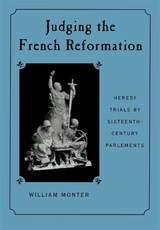 Judging the French Reformation: Heresy Trials by Sixteenth-Century Parlements
William Monter
Harvard University Press, 1999 This original look at the French Reformation pits immovable object--the French appellate courts or parlements--against irresistible force--the most dynamic forms of the Protestant Reformation. Without the slightest hesitation, the high courts of Renaissance France opposed these religious innovators. By 1540, the French monarchy had largely removed the prosecution of heresy from ecclesiastical courts and handed it to the parlements. Heresy trials and executions escalated dramatically. But within twenty years, the irresistible force had overcome the immovable object: the prosecution of Protestant heresy, by then unworkable, was abandoned by French appellate courts.
Until now no one has investigated systematically the judicial history of the French Reformation. William Monter has examined the myriad encounters between Protestants and judges in French parlements, extracting information from abundant but unindexed registers of official criminal decisions both in Paris and in provincial capitals, and identifying more than 425 prisoners condemned to death for heresy by French courts between 1523 and 1560. He notes the ways in which Protestants resisted the French judicial system even before the religious wars, and sets their story within the context of heresy prosecutions elsewhere in Reformation Europe, and within the long-term history of French criminal justice.
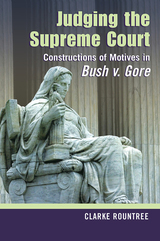 Judging the Supreme Court: Constructions of Motives in Bush v. Gore
Clarke Rountree
Michigan State University Press, 2007 This volume questions the motives of Supreme Court justices in a landmark case: The Supreme Court's intervention in the presidential election of 2000, and its subsequent decision in favor of George W. Bush, elicited immediate, heated, and widespread debate. Critics argued that the justices used weak legal arguments to overturn the Florida Supreme Court's ruling, ending a ballot recount and awarding the presidency to Bush. More fundamentally, they questioned the motives of conservative judges who arrived at a decision in favor of the candidate who reflected their political leanings.
Judging the Supreme Court examines this controversial case and the extensive attention it has received. To fully understand the case, Clarke Rountree argues, we must understand "judicial motives." These are comprised of more than each judge's personal opinions. Judges' motives, which Rountree calls "rhetorical performances," are as influential and publicly discussed as their decisions themselves. Before they are dissected in the media, judges' motives are carefully crafted by the decision- makers themselves, their critics, and their defenders. Justices consider not only the motives of the government, of military officials, of criminals, of public speakers, and of others, they also consider, construct, construe, spin, and deconstruct the motives of dissenters (whom they want to show are "misguided"), earlier courts, lower courts, and, especially, themselves.
Every judicial opinion is essentially a portrait of motives that says, "Here's what we did and here's why we did it." Well-constructed judicial motives reinforce the idea that we live under "the rule of law," while motives articulated less successfully raise questions about the legitimacy not just of individual judicial decisions but also of our political system and its foundation on an impartial judiciary. In Bush v. Gore, Rountree concludes, the judges of the majority opinion were not motivated by judicial concerns about law and justice, but rather by their own political and personal motives.
 Judging under Uncertainty: An Institutional Theory of Legal Interpretation
Adrian Vermeule
Harvard University Press, 2006 How should judges, in America and elsewhere, interpret statutes and the Constitution? Previous work on these fundamental questions has typically started from abstract views about the nature of democracy or constitutionalism, or the nature of legal language, or the essence of the rule of law. From these conceptual premises, theorists typically deduce an ambitious role for judges, particularly in striking down statutes on constitutional grounds. In this book, Adrian Vermeule breaks new ground by rejecting both the conceptual approach and the judge-centered conclusions of older theorists. Vermeule shows that any approach to legal interpretation rests on institutional and empirical premises about the capacities of judges and the systemic effects of their rulings. Drawing upon a range of social science tools from political science, economics, decision theory, and other disciplines, he argues that legal interpretation is above all an exercise in decisionmaking under severe empirical uncertainty. In view of their limited information and competence, judges should adopt a restrictive, unambitious set of tools for interpreting statutory and constitutional provisions, deferring to administrative agencies where statutes are unclear and deferring to legislatures where constitutional language is unclear or states general aspirations.
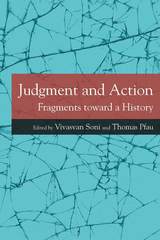 Judgment and Action: Fragments toward a History
Edited by Vivasvan Soni and Thomas Pfau
Northwestern University Press, 2018 Written by theologians, literary scholars, political theorists, classicists, and philosophers, the essays in Judgment and Action address the growing sense that certain key concepts in humanistic scholarship have become suspect, if not downright unintelligible, amid the current plethora of critical methods. These essays aim to reassert the normative force of judgment and action, two concepts at the very core of literary analysis, systematic theology, philosophy, ethics, aesthetics, and other disciplines.
Interpretation is essential to every humanistic discipline, and every interpretation is an act of judgment. Yet the work of interpretation and judgment has been called into question by contemporary methods in the humanities, which incline either toward contextual determination of meaning or toward the suspension of judgment altogether. Action is closely related to judgment and interpretation and like them, it has been rendered questionable. An action is not simply the performance of a deed but requires the deed’s intelligibility, which can be secured only through interpretation and judgment.
Organized into four broad themes—interiority/contemplation, ethics, politics/community, and aesthetics/image—the aim of this broad-ranging and insightful collection is to illuminate the histories of judgment and action, identify critical sites from which rethinking them may begin, clarify how they came to be challenged, and relocate them within a broader intellectual-historical trajectory that renders them intelligible.
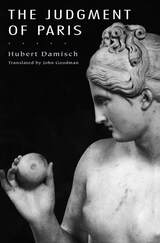 The Judgment of Paris
Hubert Damisch
University of Chicago Press, 1996 Drawing on Freudian theories of sexuality and Kant's conception of the beautiful, French art historian Hubert Damisch considers artists as diverse as Raphael, Picasso, Watteau, and Manet to demonstrate that beauty has always been connected to ideas of sexual difference and pleasure. Damisch's tale begins with the judgment of Paris, in which Paris awards Venus the golden apple and thus forever links beauty with desire. The casting of this decision as a mistake—in which desire is rewarded over wisdom and strength—is then linked to theories of the unconscious and psychological drives. In his quest for an exposition of the beautiful in its relation to visual pleasure, Damisch employs what he terms “analytic iconology,” following the revisions and repetitions of the motif of the judgment through art history, philosophy, aesthetics, and psychoanalysis. This translation brings an important figure of the French art historical tradition to Anglo-American audiences.
The Judgment of the Nations
Christopher Dawson
Catholic University of America Press, 2011 Christopher Dawson wrote The Judgment of the Nations in 1942, in the midst of the horrors of World War II.
Judicial Aspects of Foreign Relations: In Particular of the Recognition of Foreign Powers
Louis L. Jaffe
Harvard University Press The long-delayed recognition of the Russian Soviets, which has provided courts throughout the world with a host of perplexing questions as to the rights and immunities of unrecognized powers and the effect of their laws and decrees, is one of the many specific problems discussed by Mr Jaffe in this important volume. As a basis, he examines the relations between the judiciary and the executive, and indicates the extent to which considerations of extra-national policy have already penetrated judicial decision. In developing a theory of the function of recognition, he considers the theories of the past and the present, the history out of which they grew, their relation to the basic concepts of international law and in particular to the theory of external sovereignty, and their truth and value in terms of current practice and current needs.
 Judicial Control of the Federal Trade Commission and the Interstate Commerce Commission, 1920-1930: A Comparative Study in the Relations of Courts to Administrative Commissions
Carl McFarland
Harvard University Press This volume is a presentation of the doctrinal and practical aspects of the problem of judicial control over administrative boards and commissions. For the purpose of example and to present a stereoscopic view of the development of administrative justice in the United States, the two preeminent and independent commissions of the Federal government charged with the regulation of trade and transportation are treated in some detail. Separate chapters are devoted to the Interstate Commerce Commission from its inception in 1889 and to the Federal Trade Commission from its beginnings in 1914, with particular reference to the relations of these commissions to the courts during the decade from 1920 to 1930 in order to disclose the nature of the judicial control and the measure of authority allowed the administrative bodies.
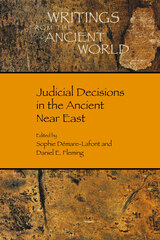 Judicial Decisions in the Ancient Near East
Sophie Démare-Lafont
SBL Press, 2023 This volume presents the first broadly inclusive collection, with accessible text and English translation, of documents related to judicial decisions in the ancient Near East, the oldest setting for such writing in the world. The texts in this volume belong to various genres, especially legal records and letters, and span almost two thousand years. With such varied material, the work depends on the expertise of specialists in each setting, from the Sumerian of early Ur to the late Akkadian of Babylonia under the Persians. The collection brings together not only 183 transliterated texts and new translations but also introductions and commentary that place these legal documents in their historical and social contexts. A glossary of legal terms, a concordance of texts included, and an index of legal terms makes this an invaluable tool for students and scholars across disciplines. The contributors are Dominique Charpin, Sophie Démare-Lafont, Daniel E. Fleming, Francis Joannès, Bertrand Lafont, Brigitte Lion, Ignacio Márquez Rowe, Cécile Michel, and Pierre Villard.
 Judicial Institutions in Nineteenth-Century Latin America
Edited by Eduardo Zimmermann
University of London Press, 1999 The relevance of lawyers and jurists in the process of state-building in nineteenth-century Latin America has been widely acknowledged. This collection of essays assembles a series of studies dealing with the interaction between the legal world and the wider political, economic, social and cultural processes in which the transition from colonial status to independent nationhood took place. Rather than viewing this transition as a radical transformation of judicial institutions and practices, emphasis has been put upon the continuities between those two phases. The chapters range from general overviews of both colonial and republican Spanish America to more detailed case studies of Mexico, Brazil and Argentina. contributors include: Linda Arnold, Virginia Tech; Osvaldo Barreneche, Universidad Nacional de la Plata, Argentina; Charles R. Cutter, Purdue University; Thomas H. Holloway, Cornell University; Victor M. Uribe, Florida International University.
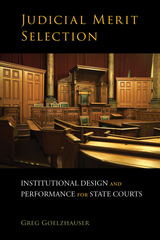 Judicial Merit Selection: Institutional Design and Performance for State Courts
Greg Goelzhauser
Temple University Press, 2019 The judicial selection debate continues. Merit selection is used by a majority of states but remains the least well understood method for choosing judges. Proponents claim that it emphasizes qualifications and diversity over politics, but there is little empirical evidence regarding its performance. In Judicial Merit Selection, Greg Goelzhauser amasses a wealth of data to examine merit selection’s institutional performance from an internal perspective. While his previous book, Choosing State Supreme Court Justices, compares outcomes across selection mechanisms, here he delves into what makes merit selection unique—its use of nominating commissions to winnow applicants prior to gubernatorial appointment. Goelzhauser’s analyses include a rich case study from inside a nominating commission’s proceedings as it works to choose nominees; the use of public records to examine which applicants commissions choose and which nominees governors choose; evaluation of which attorneys apply for consideration and which judges apply for promotion; and examination of whether design differences across systems impact performance in the seating of qualified and diverse judges. The results have critical public policy implications.
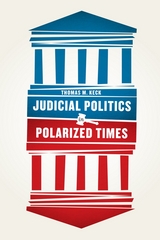 Judicial Politics in Polarized Times
Thomas M. Keck
University of Chicago Press, 2014 When the Supreme Court upheld the Affordable Care Act, some saw the decision as a textbook example of neutral judicial decision making, noting that a Republican Chief Justice joined the Court’s Democratic appointees to uphold most provisions of the ACA. Others characterized the decision as the latest example of partisan justice and cited the actions of a bloc of the Court’s Republican appointees, who voted to strike down the statute in its entirety. Still others argued that the ACA’s fate ultimately hinged not on the Court but on the outcome of the 2012 election. These interpretations reflect larger stories about judicial politics that have emerged in polarized America. Are judges neutral legal umpires, unaccountable partisan activists, or political actors whose decisions conform to—rather than challenge—the democratic will?
Drawing on a sweeping survey of litigation on abortion, affirmative action, gay rights, and gun rights across the Clinton, Bush, and Obama eras, Thomas M. Keck argues that, while each of these stories captures part of the significance of judicial politics in polarized times, each is also misleading. Despite judges’ claims, actual legal decisions are not the politically neutral products of disembodied legal texts. But neither are judges “tyrants in robes,” undermining democratic values by imposing their own preferences. Just as often, judges and the public seem to be pushing in the same direction. As for the argument that the courts are powerless institutions, Keck shows that their decisions have profound political effects. And, while advocates on both the left and right engage constantly in litigation to achieve their ends, neither side has consistently won. Ultimately, Keck argues, judges respond not simply as umpires, activists, or political actors, but in light of distinctive judicial values and practices.
Judicial Power and Reconstruction Politics
Stanley I. Kutler
University of Chicago Press, 1968 A study of the Supreme Court in the wake of the Dred Scott decision.
This book investigates the political and public standing of the Supreme Court following the Dred Scott decision. Arguing against interpretations by previous historians, Kutler asserts instead that the "Chase Court" was neither enfeebled by the decision itself, nor by congressional Republicans during reconstruction. Instead, Kutler suggests that during reconstruction, the Court was characterized by forcefulness and judicious restraint rather than timidity and cowardice, holding a creative and determining role rather than abdicating its rightful powers. This volume assembles a series of essays by Kutler arguing for this characterization. Provocative and persuasive at turns, this collection of essays provides a bold and innovative reinterpretation of the Supreme Court after the Civil War.
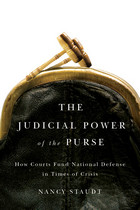 The Judicial Power of the Purse: How Courts Fund National Defense in Times of Crisis
Nancy Staudt
University of Chicago Press, 2011 Congress and the president are not the only branches that deal with fiscal issues in times of war. In this innovative book, Nancy Staudt focuses on the role of federal courts in fiscal matters during warfare and high-cost national defense emergencies. There is, she argues, a judicial power of the purse that becomes evident upon examining the budgetary effects of judicial decision making. The book provides substantial evidence that judges are willing—maybe even eager—to redirect private monies into government hands when the country is in peril, but when the judges receive convincing cues that ongoing wartime activities undermine the nation’s interests, they are more likely to withhold funds from the government by deciding cases in favor of private individuals and entities who show up in court.
In stark contrast with conventional legal, political, and institutional thought that privileges factors associated with individual preferences, The Judicial Power of the Purse sheds light on environmental factors in judicial decision making and will be an excellent read for students of judicial behavior in political science and law.
 Judicial Reform as Political Insurance: Argentina, Peru, and Mexico in the 1990s
Jodi S. Finkel
University of Notre Dame Press, 2008
During the 1990s, judicial reform swept Latin America. While some of the region's supreme courts have been able to exercise increased power as a result of these reforms, others have not. Why do some instances of judicial reform appear to be leading to the development of a powerful judiciary while others have failed to do so? In this careful analysis, Jodi S. Finkel investigates judicial reform in Argentina, Mexico, and Peru. She suggests that while ruling parties can be induced to initiate judicial reforms by introducing constitutional revisions, they often prove unwilling to implement these constitutional changes by enacting required legislation.
To understand the outcomes of judicial reform, as well as to predict where reforms are likely to empower courts, it is necessary to examine the political incentives faced by politicians at the implementation phase. Finkel argues that the implementation of judicial reform may serve the ruling party as an insurance policy, in that a strong judicial branch reduces the risks faced by a ruling party once it loses power and becomes the opposition. Finkel suggests that as the ruling party's probability of reelection declines, the likelihood of the enactment of reforms resulting in an empowered judiciary increases.
“This book will be of interest for those in Latin American studies, where it should be well-received due to the author’s close familiarity with and authority on the countries about which she writes; for scholars in the law and society field, where it supports and complements the work of Ginsburg and Hirschl; and to those in the policy field, to whom the book offers several important lessons.” —Lisa Hilbink, University of Minnesota
“By highlighting politicians' interest in protection against future threats, Jodi Finkel convincingly explains their seemingly paradoxical decision to enact judicial reforms that limit their own power. Her book constitutes a particularly interesting, thoughtful, and theoretically significant contribution to the burgeoning literature on judicial politics in Latin America.” —Kurt Weyland, Lozano Long Professor of Latin American Politics, University of Texas at Austin
“In this lucid study, Jodi Finkel extends our understanding of the politics of judicial empowerment with three case studies from Latin America. Well written and tightly argued, the book makes a convincing case that the incentives of politicians, rather than pressure from civil society or external actors, are the key factor to explain variation in judicial reform. Finkel has made a major contribution to the nascent literature on judicial politics in Latin America. “ —Tom Ginsburg, University of Illinois
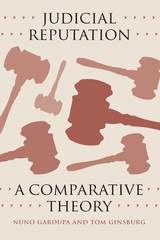 Judicial Reputation: A Comparative Theory
Nuno Garoupa and Tom Ginsburg
University of Chicago Press, 2015 Judges are society’s elders and experts, our masters and mediators. We depend on them to dispense justice with integrity, deliberation, and efficiency. Yet judges, as Alexander Hamilton famously noted, lack the power of the purse or the sword. They must rely almost entirely on their reputations to secure compliance with their decisions, obtain resources, and maintain their political influence.
In Judicial Reputation, Nuno Garoupa and Tom Ginsburg explain how reputation is not only an essential quality of the judiciary as a whole, but also of individual judges. Perceptions of judicial systems around the world range from widespread admiration to utter contempt, and as judges participate within these institutions some earn respect, while others are scorned. Judicial Reputation explores how judges respond to the reputational incentives provided by the different audiences they interact with—lawyers, politicians, the media, and the public itself—and how institutional structures mediate these interactions. The judicial structure is best understood not through the lens of legal culture or tradition, but through the economics of information and reputation. Transcending those conventional lenses, Garoupa and Ginsburg employ their long-standing research on the latter to examine the fascinating effects that governmental interactions, multicourt systems, extrajudicial work, and the international rule-of-law movement have had on the reputations of judges in this era.
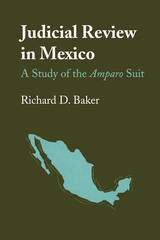 Judicial Review in Mexico: A Study of the Amparo Suit
By Richard D. Baker
University of Texas Press, 1971 The amparo suit is a Mexican legal institution similar in its effects to such Anglo-American procedures as habeas corpus, error, and the various forms of injunctive relief. It has undergone a long evolution since it was incorporated into the Constitution of 1857. Today, its principal purpose is to protect private individuals in the enjoyment of the rights guaranteed by the first twenty-nine articles of the Constitution. Mexico after its independence produced many constitutions. One of the earliest problems was to find an adequate means of defending the Constitution against ill-founded interpretations of its precepts. Like the United States, Mexico has developed a system of constitutional defense in which the judiciary is the supreme interpreter of what this document means. Unlike the United States Supreme Court, however, the Mexican Supreme Court has not been innovative in its decisions or contradicted the administration on major policy decisions. This difference must be attributed to the civil law system of Mexico as well as to the political climate. The first part of Richard D. Baker’s book describes the historical background of amparo and other methods of constitutional defense in Mexico. The three men most closely associated with creating a judicial form of constitutional defense in Mexico were Manuel Crescencio Rejón, José Fernando Ramírez, and Mariano Otero. Their own writings indicate that the immediate source of amparo must be found in the American institution of judicial review that was transmitted to Mexicans through Alexis de Tocqueville’s Democracy in America. The second part is an exposition of the workings of the amparo suit in the twentieth century and the constitutional and statutory provisions affecting it. Since 1857, when it was incorporated into article 102 of the Constitution, the amparo suit has evolved into a highly complex institution performing three functions: the defense of the civil liberties enumerated in the first twenty-nine articles of the Constitution, the determination of the constitutionality of federal and state legislation, and cassation. The Supreme Court is primarily limited to defending civil liberties through the amparo suit; it remains less innovative and more restricted than the United States system of judicial review, especially in the effect of its judgments on political agencies. Baker’s study is the first one in English dealing with this subject and is one of the most extensive in any language. It should be welcome as a valuable tool to all students of Mexican law, history, and political thought.
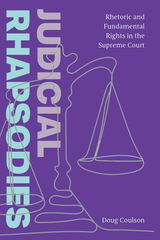 Judicial Rhapsodies: Rhetoric and Fundamental Rights in the Supreme Court
Doug Coulson
Amherst College Press, 2023 All judges legitimize their decisions in writing, but US Supreme Court justices depend on public acceptance to a unique degree. Previous studies of judicial opinions have explored rhetorical strategies that produce legitimacy, but none have examined the laudatory, even operatic, forms of writing Supreme Court justices have used to justify fundamental rights decisions. Doug Coulson demonstrates that such “judicial rhapsodies” are not an aberration but a central feature of judicial discourse.
First examining the classical origins of divisions between law and rhetoric, Coulson tracks what he calls an epideictic register—highly affective forms of expression that utilize hyperbole, amplification, and vocabularies of praise—through a surprising number of landmark Supreme Court opinions. Judicial Rhapsodies recovers and revalues these instances as significant to establishing and maintaining shared perspectives that form the basis for common experience and cooperation.
“Judicial Rhapsodies is both compelling and important. Coulson brings his well-developed knowledge of rhetoric to bear on one of the most central (and most democratically fraught) means of governance in the United States: the Supreme Court opinion. He demonstrates that the epideictic, far from being a dispensable or detestable element of judicial rhetoric, is an essential feature of how the Court operates and seeks to persuade.” —Keith Bybee, Syracuse University
 Judicial Territory: Law, Capital, and the Expansion of American Empire
Shaina Potts
Duke University Press, 2024 In Judicial Territory, Shaina Potts reveals how the American empire has benefited from the post-World War II expansion of United States judicial authority over the economic decisions of postcolonial governments. Introducing the term “judicial territory” to refer to the increasingly transnational space over which US courts wield authority, Potts argues that law is an essential tool for US geopolitical and economic interests. Through close examination of cases involving private US companies, on the one hand, and foreign state-owned enterprises, nationalizations, and sovereign debt, on the other, she shows that technical changes relating to the treatment of foreign sovereigns in domestic US law allowed the United States to extend its purview over global financial and economic relations, including many economic decisions of foreign governments. Throughout, Potts argues, US law has not become divorced from territoriality but instead actively remapped it; it has not merely responded to globalization, but actively produced it—making the whole world part of US economic space in the process.
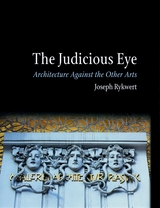 The Judicious Eye: Architecture Against the Other Arts
Joseph Rykwert
University of Chicago Press, 2008 Is architecture art? This vexed question has been posed since the 1700s, when—breaking from earlier centuries in which there were no divisions between visual artist, architect, and engineer—architects and laypeople alike began to see these vocations as distinct. Exploring how this separation of roles occurred, and how in the twentieth century arts and architecture started to come together again, The Judicious Eye is the definitive history of the relationships between painting, sculpture, and architecture as they have shifted over the past three centuries.
Joseph Rykwert locates the first major shift during the Enlightenment, when key philosophers drew implied and explicit distinctions between the visual arts and architecture. As time progressed, architects came to see themselves as part of an established profession, while visual artists increasingly moved toward society’s margins, deepening the chasm between them. Detailing the eventual attempts to heal this breach, Rykwert concludes in the mid-twentieth century, when the artistic avant-garde turned to architects in its battle against a stagnant society. The Judicious Eye, then, provides a necessary foundation for understanding architecture and visual art in the twenty-first century, as they continue to break new ground by growing closer to their intertwined roots.
 Judith Resnik: Unsung Astronaut
Marlene Targ Brill
Ohio University Press Judith Resnik didn’t grow up dreaming of space, but when NASA opened its doors to women astronauts in the late 1970s, she stepped forward—and soared. One of the first six women ever accepted into NASA’s space shuttle astronaut-training program, Resnik brought her sharp mind, determination, and creativity to a field that had long been closed to women. Although she wasn’t the first American woman in space, she became one of the most accomplished astronauts of her time. Resnik’s journey wasn’t easy. She faced challenges at home and in school, but she never let obstacles stop her. A gifted student, she excelled in math, science, and music—she even considered becoming a concert pianist before choosing a career in engineering. Her hard work paid off: She earned multiple degrees and helped design improvements for the space shuttle itself. She proved that astronauts aren’t just pilots—they’re problem solvers, inventors, and explorers. In 1984, Resnik launched into space for the first time aboard the shuttle Discovery. Two years later, she joined the crew of Challenger. Tragically, that mission ended in disaster, cutting her life short. While the world focused on the loss of teacher Christa McAuliffe, who was a passenger on that flight, Resnik’s story was often overlooked. Yet her contributions to science and space exploration live on through programs, schools, and scholarships that bear her name. This inspiring biography brings Resnik’s remarkable life to light. Readers will discover how a girl from Ohio became a trailblazer in space and how her courage and brilliance continue to inspire new generations. Her story reminds us that even if you’re not first, you can still make history—and that reaching for the stars starts with believing in yourself.
Jugaad Time: Ecologies of Everyday Hacking in India
Amit S. Rai
Duke University Press, 2019 In India, the practice of jugaad—finding workarounds or hacks to solve problems—emerged out of subaltern strategies of negotiating poverty, discrimination, and violence but is now celebrated in management literature as a disruptive innovation. In Jugaad Time Amit S. Rai explores how jugaad operates within contemporary Indian digital media cultures through the use of the mobile phone. Rai shows that despite being co-opted by capitalism to extract free creative labor from the workforce, jugaad is simultaneously a practice of everyday resistance, as workers and communities employ hacks to oppose corporate, caste, and gender power. Locating the tensions surrounding jugaad—as both premodern and postdigital, innovative and oppressive—Rai maps how jugaad can be used to undermine neoliberal capitalist media ecologies and nationalist politics.
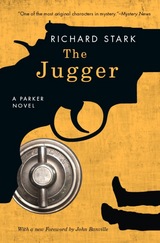 The Jugger: A Parker Novel
Richard Stark
University of Chicago Press, 2009 An action-packed crime novel starring Parker, the heister starring in the forthcoming Shane Black film Play Dirty!
Richard Stark's Parker novels are the hardest of hard-boiled, classic crime novels where the heists are huge, the body counts are high, and the bad guys usually win.
The Parker novels have been a huge influence on countless writers and filmmakers, including Quentin Tarantino, Stephen King, George Pelecanos, Colson Whitehead, Lucy Sante, John Banville, and many more. Their stripped-down language and hard-as-nails amorality create an unforgettable world where the next score could be the big one, but your next mistake could also be your last. There's nothing else like them.
They say the past always catches up to you—but if he can help it, Parker won’t let his. In The Jugger, an old contact who could blow Parker’s cover tells Parker he’s in trouble — then turns up dead. With Parker’s skeletons on the verge of escaping from their closet, he must put the pieces together—at any cost—before it’s too late.
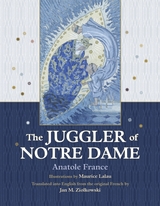 The Juggler of Notre Dame
Anatole France
Harvard University Press Once upon a time, there lived a humble juggler, Barnaby by name, who was skillful but suffered every winter from poverty. A devotee of the Virgin, he had few failings apart from enjoying drink a little too much. One day he met a monk, who persuaded him to enter a monastery. All the brethren had exceptional skills to exercise on behalf of Mary, but the juggler felt he had nothing worthy to offer. Finally, he had the notion to juggle copper balls and knives before the altar of the Virgin in the chapel. The others caught him in the act and deemed his behavior madness, but after seeing the Mother of God descend to soothe him, they realized that he was blessed.
Writers, illustrators, and musicians from the Middle Ages to the present have loved this simple, medieval tale. In 1890, Anatole France (1844–1924) adapted the original poem as the short story “Le jongleur de Notre-Dame.” Dumbarton Oaks is pleased to bring this version back into print for the enjoyment of modern audiences, featuring a translation by Jan M. Ziolkowski and Art Deco illustrations by Maurice Lalau (1881–1961), faithfully reproduced from a 1924 printing.
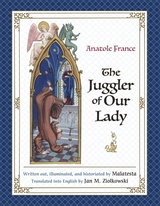 The Juggler of Our Lady
Anatole France
Harvard University Press Once upon a time, there lived a humble juggler, Barnaby by name, who was skillful but suffered every winter from poverty. A devotee of the Virgin, he had few failings apart from enjoying drink a little too much. One day he met a monk, who persuaded him to enter a monastery. All the brethren had exceptional skills to exercise on behalf of Mary, but the juggler felt he had nothing worthy to offer. Finally, he had the notion to juggle copper balls and knives before the altar of the Virgin in the chapel. The others caught him in the act and deemed his behavior madness, but after seeing the Mother of God descend to soothe him, they realized that he was blessed.
In 1890, Anatole France (1844–1924) adapted this medieval French poem as the short story “Le jongleur de Notre-Dame,” republished in 1906 with illustrations by Henri Malteste (1881–1961)—who signed his work “Malatesta”—a specialist in medievalesque illustrations and calligraphy. Dumbarton Oaks is pleased to bring this version back for the enjoyment of modern audiences both young and old, with artwork reproduced from original gouaches, and a translation by Jan M. Ziolkowski facing the French text.
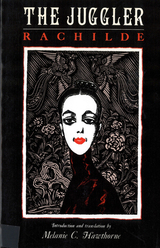 The Juggler: Rachilde
Hawthorne, Melanie C
Rutgers University Press, 1990 The Juggler (La Jongleuse) is a "decadent" novel that was first published in 1900. Its author, Marguerite Vallette-Eymery (1860-1953), who used the pseudonym Rachilde, was a prolific novelist (over sixty works of fiction), playwright, literary critic and reviewer, and a forceful presence in French literary society of her time. The protagonist of the novel, Eliante Donalger, is in some sense an exaggerated double for her creator--bizarre in appearance, clothing, and interests. Instinctively grasping a medical and psychological truth that the turn-of-the-century scientific world was only beginning to understand, Eliante maintains that there is nothing "natural" about human sexual expression. She claims to be in love with an inanimate (though anthropomorphic and sexually ambiguous) object, a Greek amphora, and the novel traces the rivalry between this faithful partner and an ardent human suitor, a young medical student. It is only through juggling, both literally and metaphorically, that Eliante is able to use her seductive power to maintain desire. The surprise ending challenges the limits of such power in a controversial and surprising twist. Although Rachilde's work has been neglected in the past, the women's movement and feminist criticism have stimulated renewed interest in her fiction. The Juggler is a major rediscovery.
Juggling
Stewart Lawrence Sinclair
Duke University Press, 2023 In Juggling, Stewart Lawrence Sinclair explores the four-thousand-year history and practice of juggling as seen through his life as a juggler. Sinclair—who learned to juggle as a child and paid his way through college by busking—shares his experiences of taking up juggling after an episode of suicidal ideation, his time juggling on the streets, and ultimately finding comfort in juggling during the COVID-19 pandemic. In many ways, this is a book about loss and recovery. From his own juggling story to clowns braving military checkpoints in Bosnia and Rwanda to perform in refugee camps to contemporary avant-garde performances, Sinclair shows how the universal language of juggling provides joy as well as a respite from difficulties during hard times.
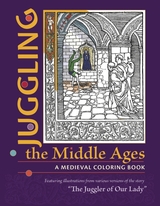 Juggling the Middle Ages: A Medieval Coloring Book
Dumbarton Oaks, Trustees for Harvard University
Harvard University Press Once upon a time, there lived in France a humble juggler, Barnaby by name, who was skillful but suffered every winter from poverty. A devotee of the Virgin, he had few failings apart from enjoying drink a little too much. One day he met a monk, who persuaded him to enter a monastery. There he felt miserable at his inability to show his devotion to the Virgin Mary as the other monks did. Then an idea came to him: he would perform before the Madonna! The monks caught him and were outraged or thought he was mad, but soon they saw the Virgin descend from the altar to soothe him. He may be simple, but his heartfelt offering of talent was appreciated. The moral? We do not need to be maestros or to have much money and master’s degrees. We all have something to give.
This simple story has medieval beginnings—a lovely poem often known as “Our Lady’s Tumbler” that dates to the 1230s. Many writers and artists have been inspired by it, and the line art in this coloring book was thoughtfully chosen and carefully prepared from books published a century or so ago. Enjoy the beauty of these illustrations as you add your own colors to the story!
Juju: A Social History and Ethnography of an African Popular Music
Christopher Alan Waterman
University of Chicago Press, 1990 Now known internationally through the recordings of King Sunny Ade and others, juju music originated more than fifty years ago among the Yoruba of Nigeria. This history and ethnography of juju is the first detailed account of the evolution and social significance of a West African popular music. Enhanced with maps, color photographs of musicians and dance parties, musical transcriptions, interviews with musicians, and a glossary of Yoruba terms, Juju is an invaluable contribution to scholarship and a boon to fans who want to discover the roots of this vibrant music.
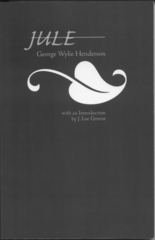 Jule
George Wylie Henderson
University of Alabama Press, 1989 This novel is about a young man, Jule, who grew up in rural Alabama in the 1930s. He experienced a peaceful farm life filled with hard work in the hot sun followed by socializing by moonlight in the cooling hours of the night. His mother, Ollie Miss, raised him “to be somebody,” as she said, and he always knew that he would follow her advice. As he grew, he developed a close friendship with the white storekeeper’s son, Rollo, and an earthly love for Berta Mae, a neighbor girl. This quiet life changed abruptly for the young Negro boy when he fled Alabama and arrived in Harlem, there to gain a foothold in that world center of black social and economic power. Although a novel, Jule is strongly autobiographical and gives insight into a vanished Harlem, a glittering community that produced a rich outpouring of distinctively American literary works. J. Lee Greene’s introduction places the novel in the context of the time and links this work with Henderson’s earlier novel – Ollie Miss, also available from the University of Alabama Press – establishing its rightful place in Afro-American literature.
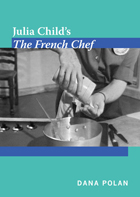 Julia Child's The French Chef
Dana Polan
Duke University Press, 2011 Julia Child’s TV show, The French Chef, was extraordinarily popular during its broadcast from 1963 until 1973. Child became a cultural icon in the 1960s, and, in the years since, she and her show have remained enduring influences on American cooking, American television, and American culture. In this concise book, Dana Polan considers what made Child’s program such a success. It was not the first televised cooking show, but it did define and popularize the genre. Polan examines the development of the show, its day-to-day production, and its critical and fan reception. He argues that The French Chef changed the conventions of television’s culinary culture by rendering personality indispensable. Child was energetic and enthusiastic, and her cooking lessons were never just about food preparation, although she was an effective and unpretentious instructor. They were also about social mobility, the discovery of foreign culture, and a personal enjoyment and fulfillment that promised to transcend domestic drudgery. Polan situates Julia Child and The French Chef in their historical and cultural moment, while never losing sight of Child’s unique personality and captivating on-air presence.
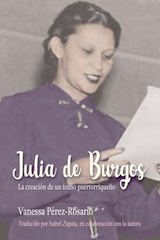 Julia de Burgos: La creación de un ícono puertorriqueño
Vanessa Pérez-Rosario. Traducido por Isabel Zapata, en colaboración con la autora
University of Illinois Press, 2021 Durante más de cincuenta años, Julia de Burgos ha evocado sentimientos de identidad y unión entre puertorriqueños y latinxs en Estados Unidos. Vanessa Pérez-Rosario va más allá del enfoque trágico de otras biografías de Burgos para examinar la vida de la artista considerando el trasfondo de la cultura puertorriqueña y la compleja historia de la isla y la diáspora. Enfocándose en Burgos como escritora y activista, Pérez-Rosario profundiza en su desarrollo artístico, su experiencia como migrante, sus luchas contra el colonialismo y la injusticia social y sus contribuciones a la cultura literaria y visual latinoamericanas. Al mismo tiempo, desentraña las dinámicas culturales y políticas que operan en las revisiones y reinvenciones de Burgos que escritores y artistas latinxs contemporáneos en Nueva York llevan a cabo para imaginar nuevas posibilidades para sí mismos y sus comunidades. Disponible por primera vez en español, Julia de Burgos cuenta la destacada historia de la poeta y activista puertorriqueña.
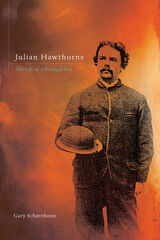 Julian Hawthorne: The Life of a Prodigal Son
Gary Scharnhorst
University of Illinois Press, 2014 Julian Hawthorne (1846-1934), Nathaniel Hawthorne's only son, lived a long and influential life marked by bad circumstances and worse choices. Raised among luminaries such as Thoreau, Emerson, and the Beecher family, Julian became a promising novelist in his twenties, but his writing soon devolved into mediocrity. What talent the young Hawthorne had was spent chasing across the changing literary and publishing landscapes of the period in search of a paycheck, writing everything from potboilers to ad copy. Julian was consistently short of funds because--as biographer Gary Scharnhorst is the first to reveal--he was supporting two households: his wife in one and a longtime mistress in the other. The younger Hawthorne's name and work ethic gave him influence in spite of his haphazard writing. Julian helped to found Cosmopolitan and Collier's Weekly. As a Hearst stringer, he covered some of the era's most important events: McKinley's assassination, the Galveston hurricane, and the Spanish-American War, among others. When Julian died at age 87, he had written millions of words and more than 3,000 pieces, out-publishing his father by a ratio of twenty to one. Gary Scharnhorst, after his own long career including works on Mark Twain, Oscar Wilde, and other famous writers, became fascinated by the leaps and falls of Julian Hawthorne. This biography shows why.
 Julian of Norwich and the Mystical Body Politic of Christ
Frederick Christian Bauerschmidt
University of Notre Dame Press, 1999
In May 1373, the English mystic Julian of Norwich was healed of a serious illness after experiencing a series of visions of the Blessed Virgin and of Christ’s suffering. Her account, A Revelation of Love, is considered one of the most remarkable documents of medieval religious experience. In Julian of Norwich and the Mystical Body Politic of Christ, Frederick Bauerschmidt provides a close and historically sensitive reading of Julian’s Revelation of Love that addresses the relationship between our understanding of God and our vision of human community. By locating Julian’s images of Christ’s body within the context of late medieval debates over the nature and extent of divine power, Bauerschmidt argues that Julian presents an alternative account of divine power in which the crucified body of Christ becomes the locus and shape of divine omnipotence.
For Julian, divine power serves as the norm of all human exercise of power, rendering the possibility of the “mystical body politic of Christ” as the exemplary form of human community. In this reading, the theological is irreducibly political and the political is irreducibly theological. As such, Bauerschmidt shows Julian to be both a theologian of the first rank and one who “imagines the political.”
"Much recent writing on the medieval "mystical" traditions seems either to take a thin slice of concepts through the complex matrix of historical context, or else to offer historical focus at the expense of contemporary relevance. Bauerschmidt's Julian of Norwich and the Mystical Body Politic of Christ is a remarkable achievement of synthesis between a theologico-political analysis of distinct contemporary relevance and historical faithfulness to Julian's own fourteenth century world." —Denys Turner, H.G. Wood Professor of Theology at the University of Birmingham, England
"With astonishing lucidity, Bauerschmidt proves himself to be a most delicate reader of Julian at the same time as he draws, always with relevance, on a range of powerful contemporary theorists to facilitate our understanding of the scope, depth, and contemporary force of Julian's mystical and political theology." —David Aers, James B. Duke Professor of English and Director of the Center for Medieval and Renaissance Studies at Duke University
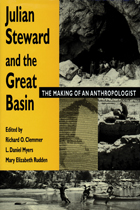 Julian Steward and the Great Basin: The Making of an Anthropologist
Richard O Clemmer
University of Utah Press, 1999 Julian Steward and the Great Basin is a critical assessment of Steward’s work, the factors that influenced him, and his deep effect on American anthropology. Steward (1902–1972) was one of the foremost American exponents of cultural ecology, the idea that societies evolve in adaptation to their human and natural environments. He was also central in shaping basic anthropological constructs such as "hunter-gatherer" and "adaptation." But his fieldwork took place almost entirely in the Great Basin. In one sense, the phases of Steward’s career epitomize the successive schools of anthropological theory and practice. Each chapter explores a different aspect of his work ranging from early efforts at documenting trait distributions to his later role in the development of social transformation theory, area studies, and applied anthropology. Julian Steward and the Great Basin also corrects long-standing misperceptions that originated with Steward about lifeways of the Indians living between the Great Plains and California. It charts new directions for research, demanding a more exacting study of environmental conditions, material adaptations, and organizational responses, as well as an appreciation of the ideological and humanistic dimensions of Basin Life.
Julian the Apostate
G. W. Bowersock
Harvard University Press, 1978 This portrayal of one of antiquity’s most enigmatic figures offers a vivid and compact assessment of the Apostate’s life and reign. Proceeding directly from an evaluation of the ancient sources—the testimony of friends and enemies of Julian as well as the writings of the emperor himself—the author traces Julian’s youth, his years as the commander of the Roman forces in Gaul, and his emergence as sole ruler in the course of a dramatic march to Constantinople. In G. W. Bowersock’s analysis of Julian’s religious revolution, the emperor’s ardent espousal of a lost cause is seen to have made intolerable demands upon pagans, Jews, and Christians alike.
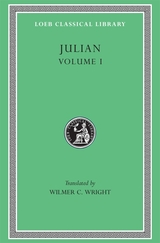 Julian, Volume I: Orations 1–5
Julian
Harvard University Press The emperor who renounced Christianity.
Julian (Flavius Claudius Iulianus) “the Apostate,” Roman Emperor, lived AD 331 or 332 to 363. Born and educated in Constantinople as a Christian, after a precarious childhood he devoted himself to literature and philosophy and became a pagan, studying in various Greek cities. In 355 his cousin Emperor Constantius called him from Athens to the court at Milan, entitled him “Caesar,” and made him governor of Gaul. Julian restored Gaul to prosperity and good government after the ravages of the Alamanni (he overthrew them at the battle of Strassburg in 357) and other Germans. Between 357 and 361 Julian’s own soldiers, refusing to serve in the East at Constantius’ orders, nearly involved Julian in war with Constantius—who, however, died in 361, making Julian sole Emperor of the Roman world. He began many reforms and proclaimed universal toleration in religion but pressed for the restoration of the older pagan worships. In 362–363 he prepared at Constantinople and then at Antioch for his expedition against Persia ruled by Shapur II. He died of a wound received in desperate battle.
Julian’s surviving works (lost are his Commentaries on his western campaigns), all in Greek, are given in the Loeb Classical Library in three volumes. The eight Orations (1–5 in Volume I, 6–8 in Volume II) include two in praise of Constantius, one praising Constantius’ wife Eusebia, and two theosophical hymns (in prose) or declamations, of interest for studies in neo-Platonism, Mithraism, and the cult of the Magna Mater in the Roman world. Misopogon (“Beard-hater”), in Volume II, assails the morals of people in Antioch; the Letters (more than eighty), in Volume III, include edicts or rescripts, mostly about Christians, encyclical or pastoral letters to priests, and private letters. Lastly in Volume III are the fragments of the work Against the Galilaeans (the Christians), written mainly to show that evidence for the idea of Christianity is lacking in the Old Testament.
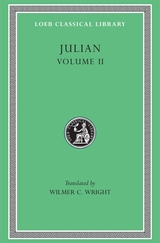 Julian, Volume II: Orations 6–8. Letters to Themistius; to the Senate and People of Athens; to a Priest. The Caesars. Misopogon
Julian
Harvard University Press The emperor who renounced Christianity.
Julian (Flavius Claudius Iulianus) “the Apostate,” Roman Emperor, lived AD 331 or 332 to 363. Born and educated in Constantinople as a Christian, after a precarious childhood he devoted himself to literature and philosophy and became a pagan, studying in various Greek cities. In 355 his cousin Emperor Constantius called him from Athens to the court at Milan, entitled him “Caesar,” and made him governor of Gaul. Julian restored Gaul to prosperity and good government after the ravages of the Alamanni (he overthrew them at the battle of Strassburg in 357) and other Germans. Between 357 and 361 Julian’s own soldiers, refusing to serve in the East at Constantius’ orders, nearly involved Julian in war with Constantius—who, however, died in 361, making Julian sole Emperor of the Roman world. He began many reforms and proclaimed universal toleration in religion but pressed for the restoration of the older pagan worships. In 362–363 he prepared at Constantinople and then at Antioch for his expedition against Persia ruled by Shapur II. He died of a wound received in desperate battle.
Julian’s surviving works (lost are his Commentaries on his western campaigns), all in Greek, are given in the Loeb Classical Library in three volumes. The eight Orations (1–5 in Volume I, 6–8 in Volume II) include two in praise of Constantius, one praising Constantius’ wife Eusebia, and two theosophical hymns (in prose) or declamations, of interest for studies in neo-Platonism, Mithraism, and the cult of the Magna Mater in the Roman world. Misopogon (“Beard-hater”), in Volume II, assails the morals of people in Antioch; the Letters (more than eighty), in Volume III, include edicts or rescripts, mostly about Christians, encyclical or pastoral letters to priests, and private letters. Lastly in Volume III are the fragments of the work Against the Galilaeans (the Christians), written mainly to show that evidence for the idea of Christianity is lacking in the Old Testament.
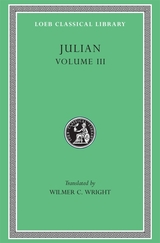 Julian, Volume III: Letters. Epigrams. Against the Galilaeans. Fragments
Julian
Harvard University Press The emperor who renounced Christianity.
Julian (Flavius Claudius Iulianus) “the Apostate,” Roman Emperor, lived AD 331 or 332 to 363. Born and educated in Constantinople as a Christian, after a precarious childhood he devoted himself to literature and philosophy and became a pagan, studying in various Greek cities. In 355 his cousin Emperor Constantius called him from Athens to the court at Milan, entitled him “Caesar,” and made him governor of Gaul. Julian restored Gaul to prosperity and good government after the ravages of the Alamanni (he overthrew them at the battle of Strassburg in 357) and other Germans. Between 357 and 361 Julian’s own soldiers, refusing to serve in the East at Constantius’ orders, nearly involved Julian in war with Constantius—who, however, died in 361, making Julian sole Emperor of the Roman world. He began many reforms and proclaimed universal toleration in religion but pressed for the restoration of the older pagan worships. In 362–363 he prepared at Constantinople and then at Antioch for his expedition against Persia ruled by Shapur II. He died of a wound received in desperate battle.
Julian’s surviving works (lost are his Commentaries on his western campaigns), all in Greek, are given in the Loeb Classical Library in three volumes. The eight Orations (1–5 in Volume I, 6–8 in Volume II) include two in praise of Constantius, one praising Constantius’ wife Eusebia, and two theosophical hymns (in prose) or declamations, of interest for studies in neo-Platonism, Mithraism, and the cult of the Magna Mater in the Roman world. Misopogon (“Beard-hater”), in Volume II, assails the morals of people in Antioch; the Letters (more than eighty), in Volume III, include edicts or rescripts, mostly about Christians, encyclical or pastoral letters to priests, and private letters. Lastly in Volume III are the fragments of the work Against the Galilaeans (the Christians), written mainly to show that evidence for the idea of Christianity is lacking in the Old Testament.
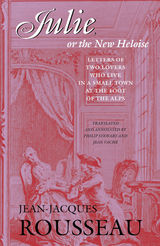 Julie, or the New Heloise: Letters of Two Lovers Who Live in a Small Town at the Foot of the Alps
Jean-Jacques Rousseau
Dartmouth College Press, 1997 An elegant translation of one of the most popular novels of its time. Rousseau's great epistolary novel, Julie, or the New Heloise, has been virtually unavailable in English since 1810. In it, Rousseau reconceptualized the relationship of the individual to the collective and articulated a new moral paradigm. The story follows the fates and smoldering passions of Julie d'Etange and St. Preux, a one-time lover who re-enters Julie's life at the invitation of her unsuspecting husband, M. de Wolmar. The complex tones of this work made it a commercial success and a continental sensation when it first appeared in 1761, and its embodiment of Rousseau's system of thought, in which feelings and intellect are intertwined, redefined the function and form of fiction for decades. As the characters negotiate a complex maze of passion and virtue, their purity of soul and honest morality reveal, as Rousseau writes in his preface, "the subtleties of heart of which this work is full." A comprehensive introduction and careful annotations make this novel accessible to contemporary readers, both as an embodiment of Rousseau's philosophy and as a portrayal of the tension and power inherent in domestic life.
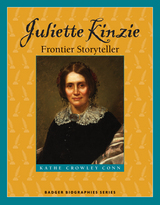 Juliette Kinzie: Frontier Storyteller
Kathe Crowley Conn
Wisconsin Historical Society Press, 2015 In 1830, a young woman named Juliette Magill Kinzie moved from her fancy home in Connecticut to a rustic log cabin in what would later be called Wisconsin. Juliette lived there with her husband, John, who worked as an Indian agent at Fort Winnebago, one of Wisconsin’s earliest settlements. While living at the fort, Juliette came to know the Indian communities that called the land home, as well as the non-Indian settlers who were moving in. She later wrote a best-selling book about her experiences, Wau-Bun: The ‘Early Day’ in the Northwest, an important first-person account of life on the frontier.
This new biography in the Badger Biographies Series turns the lens on the writer herself, detailing her life as she detailed the lives of those she encountered in the 1830s and 1840s. Juliette Kinzie: Frontier Storyteller details war, hunger, and the rapidly changing times Juliette witnessed on the Midwestern frontier, following the pioneering woman through her own changes from socialite to pioneer to famous writer and even to the work of her granddaughter, Juliette Gordon Low, who founded the Girl Scouts of the USA in 1912.
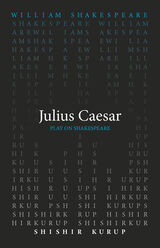 Julius Caesar
William Shakespeare
Arizona Center for Medieval and Renaissance Studies, 2022 A fresh, contemporary translation of one of Shakespeare’s most dramatic and popular plays.
Julius Caesar, Shakespeare’s famous Roman tragedy, chronicles the chaos leading up to the fateful murder of Caesar and the ensuing political fallout upon his death. Shishir Kurup’s translation updates Shakespeare’s language to allow more of the playwright’s ideas to come through; it opens the wonders and blazing relevance of the play’s rhetorical brilliance to the twenty-first century.
This translation of Julius Caesar was written as part of the Oregon Shakespeare Festival’s Play On! project, which commissioned new translations of thirty-nine Shakespeare plays. These translations present the work of “The Bard” in language accessible to modern audiences while never losing the beauty of Shakespeare’s verse. Enlisting the talents of a diverse group of contemporary playwrights, screenwriters, and dramaturges from diverse backgrounds, this project reenvisions Shakespeare for the twenty-first century. These volumes make these works available for the first time in print—a new First Folio for a new era.
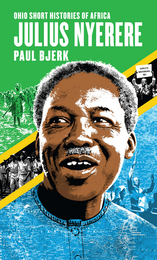 Julius Nyerere
Paul Bjerk
Ohio University Press, 2017 With vision, hard-nosed judgment, and biting humor, Julius Nyerere confronted the challenges of nation building in modern Africa. Constructing Tanzania out of a controversial Cold War union between Tanganyika and Zanzibar, Nyerere emerged as one of independent Africa’s most influential leaders. He pursued his own brand of African socialism, called Ujamaa, with unquestioned integrity, and saw it profoundly influence movements to end white minority rule in Southern Africa. Yet his efforts to build a peaceful nation created a police state, economic crisis, and a war with Idi Amin’s Uganda. Eventually—unlike most of his contemporaries—Nyerere retired voluntarily from power, paving the way for peaceful electoral transitions in Tanzania that continue today. Based on multinational archival research, extensive reading, and interviews with Nyerere’s family and colleagues, as well as some who suffered under his rule, Paul Bjerk provides an incisive and accessible biography of this African leader of global importance. Recognizing Nyerere’s commitment to participatory government and social equality while also confronting his authoritarian turns and policy failures, Bjerk offers a portrait of principled leadership under the difficult circumstances of postcolonial Africa.
 Julius Scott and the Importance of Being
Elisha P. Renne
Michigan Publishing, 2024 The book, Julius Scott and the Importance of Being, introduces readers to the historian Julius Scott, his own history, personal qualities, and work. Julius is remembered for the book, The Common Wind: Afro-American Currents in the Age of the Haitian Revolution, published in 2018, which was widely regarded as a transformative contribution to Atlantic world history. Admiringly reviewed in many important journals, the book received several awards. These accolades came as a sort of compensation at the time of worsening health, a consequence of type 1 diabetes. The consequences of having type 1 diabetes are documented with a detailed discussion of the relentless effects of this disease. Furthermore, as the first Black student to integrate Southern schools, which included his first-grade class in Houston, Texas, and later, secondary schools, first in Atlanta and then in Alabama, along with Julius’s family background, these experiences enabled him to astutely observe racism in its various forms. Throughout his life, Julius managed, despite his terrible illness, to carry on, with ingenuity, grace, and humor.
This biography of Julius Scott is based on primary and secondary sources and focuses on aspects of Julius’s life in order to underscore the personal connection between scholarly achievement, his experiences of living the United States as an African American, and the relentless consequences of having type 1 diabetes. The book, Julius Scott and the Importance of Being, also underscores the importance of documenting the continuing significance of race and religion in political life in the US and the Caribbean.
Jumano and Patarabueye: Relations at La Junta de los Rios
J. Charles Kelley with a foreword by John D. Speth
University of Michigan Press, 1986 In this volume, author J. Charles Kelley uses historical, linguistic, and archaeological data to compare two indigenous North American cultures: the Patarabueyes and the Jumanos.
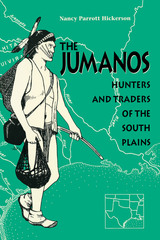 The Jumanos: Hunters and Traders of the South Plains
By Nancy Parrott Hickerson
University of Texas Press, 1994 In the late sixteenth century, Spanish explorers described encounters with North American people they called "Jumanos." Although widespread contact with Jumanos is evident in accounts of exploration and colonization in New Mexico, Texas, and adjacent regions, their scattered distribution and scant documentation have led to long-standing disagreements: was "Jumano" simply a generic name loosely applied to a number of tribes, or were they an authentic, vanished people? In the first full-length study of the Jumanos, anthropologist Nancy Hickerson proposes that they were indeed a distinctive tribe, their wide travel pattern linked over well-established itineraries. Drawing on extensive primary sources, Hickerson also explores their crucial role as traders in a network extending from the Rio Grande to the Caddoan tribes' confederacies of East Texas and Oklahoma. Hickerson further concludes that the Jumanos eventually became agents for the Spanish colonies, drafted as mercenary fighters and intelligence-gatherers. Her findings reinterpret the cultural history of the South Plains region, bridging numerous gaps in the area's comprehensive history and in the chronicle of these elusive people.
 A Jumble of Needs: Women’s Activism and Neoliberalism in the Colonias of the Southwest
Rebecca Dolhinow
University of Minnesota Press, 2010 Many immigrant communities along the U.S. border with Mexico are colonias, border settlements lacking infrastructure or safe housing. A Jumble of Needs examines the leadership of Mexican women immigrants in three colonias in New Mexico, documenting the role of NGOs in shaping women’s activism in these communities. Ethnographer Rebecca Dolhinow, who worked in the colonias, uncovers why such attempts to exercise political agency are so rarely successful. Central to the relationship between NGOs and women activists in colonias, Dolhinow argues, is the looming presence of the neoliberal political project. In particular, the discourses of caretaking that NGOs use to recruit women into leadership positions simultaneously naturalize and depoliticize the activist work that these women do in their communities. Dolhinow discovers the connections between colonias as isolated communities and colonia leaders as political subjects who unintentionally reinforce neoliberal policy. In the long run, she finds, any politicization that might take place is limited to the women leaders and seldom involves the community as a whole. Surprisingly, Dolhinow reveals, many NGOs promote neoliberal ideals, resulting in continued disenfranchisement, despite the women’s activism to better their lives, families, and communities.
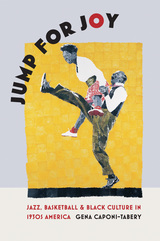 Jump for Joy: Jazz, Basketball, and Black Culture in 1930s America
Gena Caponi-Tabery
University of Massachusetts Press, 2008 If the 1930s was the Swing Era, then the years from 1937 on might well be called the Jump Era. That summer Count Basie recorded "Jumping at the Woodside," and suddenly jump tunes seemed to be everywhere. Along with the bouncy beat came a new dance step—the high-flying aerials of the jitterbuggers—and the basketball games that took place in the dance halls of African America became faster, higher, and flashier. Duke Ellington and a cast of hundreds put the buoyant spirit of the era on stage with their 1941 musical revue, Jump for Joy, a title that captured the momentum and direction of the new culture of exuberance.
Several high-profile public victories accompanied this increasing optimism: the spectacular successes of African American athletes at the 1936 Olympics, the 1937 union victory of the Brotherhood of Sleeping Car Porters, and Joe Louis's 1937 and 1938 heavyweight championship fights. For the first time in history, black Americans emerged as cultural heroes and ambassadors, and many felt a new pride in citizenship.
In this book, Gena Caponi-Tabery chronicles these triumphs and shows how they shaped American music, sports, and dance of the 1930s and beyond. But she also shows how they emboldened ordinary African Americans to push for greater recognition and civil liberties—how cultural change preceded and catalyzed political action.
Tracing the path of one symbolic gesture—the jump—across cultural and disciplinary boundaries, Caponi-Tabery provides a unique political, intellectual, and artistic analysis of the years immediately preceding World War II.
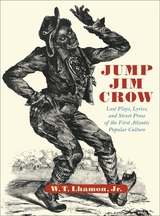 Jump Jim Crow: Lost Plays, Lyrics, and Street Prose of the First Atlantic Popular Culture
W. T. Lhamon Jr.
Harvard University Press, 2003 Beginning in the 1830s, the white actor Thomas D. Rice took to the stage as Jim Crow, and the ragged and charismatic trickster of black folklore entered—and forever transformed—American popular culture. Jump Jim Crow brings together for the first time the plays and songs performed in this guise and reveals how these texts code the complex use and abuse of blackness that has characterized American culture ever since Jim Crow’s first appearance.
Along with the prompt scripts of nine plays performed by Rice—never before published as their original audiences saw them—W. T. Lhamon, Jr., provides a reconstruction of their performance history and a provocative analysis of their contemporary meaning. His reading shows us how these plays built a public blackness, but also how they engaged a disaffected white audience, who found in Jim Crow’s sass and wit and madcap dancing an expression of rebellion and resistance against the oppression and confinement suffered by ordinary people of all colors in antebellum America and early Victorian England.
Upstaging conventional stories and forms, giving direction and expression to the unruly attitudes of a burgeoning underclass, the plays in this anthology enact a vital force still felt in great fictions, movies, and musics of the Atlantic and in the jumping, speedy styles that join all these forms.
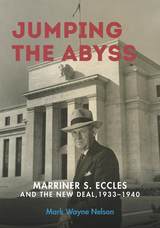 Jumping the Abyss: Marriner S. Eccles and the New Deal, 1933–1940
Mark Wayne Nelson
University of Utah Press, 2017 Mark Wayne Nelson details the efforts of one of America’s most underappreciated public servants. In 1934, Franklin D. Roosevelt invited Marriner S. Eccles, a Mormon from Utah, to join his administration. As a Republican businessman, Eccles seemed an unlikely candidate for the role of leading crusader for a fairer and more economically sound distribution of the nation’s wealth. From his first position in the Treasury Department, though, he emerged as the central mover in revolutionizing the mortgage structure of the private home market in the United States. After FDR appointed him to head the Federal Reserve, Eccles drafted legislation that restructured that institution as well. Throughout the remainder of the New Deal, he was the most powerful advocate of what came to be called “Keynesian Policy,” which involved direct federal stimulus of the economy. Presenting the first comprehensive and independent analysis of Eccles’s influential career, Jumping the Abyss wrestles with economic issues that remain relevant today.
Finalist for the Utah State Historical Society Best Book Award.
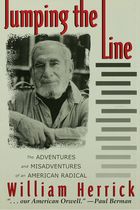 Jumping the Line: The Adventures and Misadventures of an American Radical
William Herrick
University of Wisconsin Press, 1998
An eye-opening account of time served in the great battles of our century— for workers’ rights, against Fascism, Communism, and racism—Jumping the Line is the life story of an American original. William Herrick chronicles his adventures and misadventures on the front lines of the Spanish Civil War, in (and very much out of) the Communist Party, driving a tractor on a communal farm in Michigan, jumping the line as a hobo, organizing African American sharecroppers in Georgia, at work with Orson Welles, and immersed in his own writing.
Herrick chronicles a life of great conviction and great disillusion. He went to Spain in 1936 to fight against the Fascists and there witnessed the horrifying acts that Fascists and Communists alike committed, before he was felled by a near-fatal wound. Here he tells about the life that led him, a working-class Jewish kid from New York, into the idealism and then the murky politics of this internecine conflict. From the bloody fight in Spain he takes us to the battlefields of the Communist movement in the U.S., where he found himself parading up and down the garment district of Manhattan, denouncing his former comrades.
When Paul Berman interviewed Herrick in the Village Voice in 1986, for the fiftieth anniversary of the Spanish Civil War, Herrick’s remarks so incensed other veterans of the Abraham Lincoln battalion that they picketed the paper. What William Herrick has to say doesn’t always go down easily. But for those who like the truth, with a dash of wit and a healthy dose of history, it can be exhilarating.
 Jumping the Queue: An Inquiry into the Legal Treatment of Students with Learning Disabilities
Mark Kelman and Gillian Lester
Harvard University Press, 1997 This book weighs alternative conceptions of the equal opportunity principle through an empirical and ethical exploration of the Federal law that directs local school districts to award special educational opportunities to students who are classified as learning disabled (LD). Mark Kelman and Gillian Lester consider the degree to which students with learning disabilities (rather than merely slow learners, the socially disadvantaged, or even the gifted) are entitled to benefits that might well prove advantageous to their classmates, such as extra time to complete an exam or expensive, individually tailored educational programs.
They examine the vexing question of how we should distribute extra educational funds: should we give them to those who have fewer material resources to begin with, to those who might benefit more than others from extra resources, or should we simply strive to create greater equality of outcome? The book exposes a growing conflict between those who want to distribute scarce resources on an individual basis to children who are in need whatever the reason, and those who seek to eliminate group inequalities.
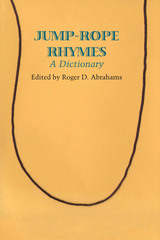 Jump-rope Rhymes: A Dictionary
Edited by Roger D. Abrahams
University of Texas Press, 1969 I had a little brother.
His name was Tiny Tim.
I put him in the bathtub
To teach him how to swim.
He drank all the water.
He ate all the soap.
He died last night
With a bubble in his throat. Jump-rope rhymes, chanted to maintain the rhythm of the game, have other, equally entertaining uses: - You can dispatch bothersome younger siblings instantly—and temporarily.
- You can learn the name of your boyfriend through the magic words "Ice cream soda, Delaware Punch, Tell me the initials of my honey-bunch."
- You can perform the series of tasks set forth in "Teddy Bear, Teddy Bear, turn around" and find out who, really, is the most nimble.
- You can even, with impunity, "conk your teacher on the bean with a rotten tangerine. "
This collection of over six hundred jump-rope rhymes, originally published in 1969, is an introduction into the world of children—their attitudes, their concerns, their humor. Like other children's folklore, the rhymes are both richly inventive and innocently derivative, ranging from on-the-spot improvisations to old standards like "Bluebells, cockleshells," with a generous sprinkling of borrowings from other play activities—nursery rhymes, counting-out rhymes, and taunts. Even adult attitudes of the time are appropriated, but expressed with the artless candor of the child: Eeny, meeny, miny, moe.
Catch Castro by the toe.
If he hollers make him say
"I surrender, U.S.A." Though aware that children's play serves social and psychological functions, folklorists had long neglected analytical study of children's lore because primary data was not available in organized form. Roger Abraham's Dictionary has provided such a bibliographical tool for one category of children's lore and a model for future compendia in other areas. The alphabetically arranged rhymes are accompanied by notes on sources, provenience, variants, and connection with other play activities.
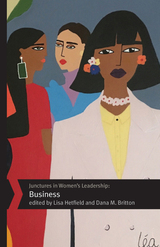 Junctures in Women's Leadership: Business
Hetfield, Lisa
Rutgers University Press, 2016 How have women managed to break through the glass ceiling of the business world, and what management techniques do they employ once they ascend to the upper echelons of power? What difficult situations have these female business leaders faced, and what strategies have they used to resolve those challenges? Junctures in Women’s Leadership: Business answers these questions by highlighting the professional accomplishments of twelve remarkable women and examining how they responded to critical leadership challenges. Some of the figures profiled in the book are household names, including lifestyle maven Martha Stewart, influential chef Alice Waters, and trailblazing African-American entrepreneur Madame C.J. Walker. Others have spent less time in the public eye, such as Johnson & Johnson executive JoAnn Heffernan Heisen, Verizon Senior Vice President Diane McCarthy, Wells Fargo technology leader Avid Modjtabai, Xerox CEO Ursula Burns, Spanx founder Sara Blakely, inventor Jane ni Dhulchaointigh, engineering firm President Roseline Marston, Calvert Investments President and CEO Barbara Krumsiek, and Merrill Lynch executive Subha Barry. These women, from diverse backgrounds, have played important roles in their respective corporations and many have worked to improve the climate for women in male-dominated industries. This is a book about women who are leading change in business. Their stories illuminate the ways women are using their power and positions—whether from the middle ranks or the top, whether from within companies or by creating their own companies. Each case study in Junctures in Women’s Leadership: Business includes a compelling and instructive story of how a woman business leader handled a critical juncture or crisis in her career. Not only does the book offer an inspiring composite portrait of women succeeding in the business world, it also provides leadership lessons that will benefit readers regardless of gender.
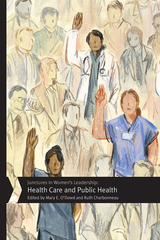 Junctures in Women's Leadership: Health Care and Public Health
Mary E. O'Dowd
Rutgers University Press, 2021 Junctures in Women’s Leadership: Health Care and Public Health offers an eclectic compilation of case studies telling the stories of women leaders in public health and health care, from Katsi Cook, Mohawk midwife, to Virginia Apgar, Katharine Dexter McCormick and Florence Schorske Wald, to Marilyn Tavenner, Suerie Moon, and more. The impact of their work is extraordinarily relevant to the current public discourse including subjects such as the global COVID-19 pandemic, disparities in health outcomes, prevention of disease and the impact of the Affordable Care Act. The leadership lessons gleaned from these chapters can be applied to a broad array of disciplines within government, private business, media, philanthropy, pharmaceutical, environmental and health sectors. Each chapter is authored by a well versed and accomplished woman, demonstrating the book’s theme that there are many paths within health care and public health. The case study format provides an introductory section providing biographical and historical background, setting the stage for a juncture, or decision point, and the resolution. The women are compelling characters and worth knowing.
Junctures in Women's Leadership: Higher Education
Carmen Twillie Ambar
Rutgers University Press, 2020 Junctures in Women's Leadership: Higher Education brings into sharp focus the unique attributes of women leaders in the academy and adds a new dimension of analysis to the field of women’s leadership studies. The research presented in this volume reveals not only theoretical factors of academic leadership, but also real time dynamics that give the reader deeper insights into the multiple stakeholders and situations that require nimble, relationship-based leadership, in addition to intellectual competency. Women leaders interviewed in this volume include Bernice Sandler, Juliet Villarreal García, and Johnnetta Betsch Cole.
 Junctures in Women’s Leadership: Media and Journalism
Linda Steiner
Rutgers University Press, 2025 The news industry is still dominated by men. Yet women have exercised leadership in journalism and related media professions in a variety of ways, from moral leadership to experimenting with structural and technological innovations and pioneering new formats to serve new audiences. This book offers a robust account of women’s leadership in journalism, looking at what motivated women to become media leaders, the obstacles they overcame, and the strategies they used to solve problems and handle crises.
This book offers profiles of inspiring women in prominent media positions from the nineteenth century to today, beginning with trailblazers like abolitionist publisher Mary Ann Shadd and Memphis Free Speech anti-lynching editor Ida B. Wells. The book takes an in-depth look at the leadership styles of well-known media moguls like Oprah Winfrey and Washington Post publisher Katharine Graham. Other chapters highlight women now emerging as media leaders, such as digital media executive S. Mitra Kalita and Iman Zawahry, a Muslim hijabi filmmaker. Bringing together cases from print, broadcast, public relations, film, and digital media, this book offers useful insights into how to be an effective leader in an ever-changing industry.
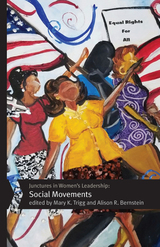 Junctures in Women's Leadership: Social Movements
Trigg, Mary K
Rutgers University Press, 2016 2016 Choice Outstanding Academic Title
From Eleanor Roosevelt to feminist icon Gloria Steinem to HIV/AIDS activist Dazon Dixon Diallo, women have assumed leadership roles in struggles for social justice. How did these remarkable women ascend to positions of influence? And once in power, what leadership strategies did they use to deal with various challenges? Junctures in Women’s Leadership: Social Movements explores these questions by introducing twelve women who have spearheaded a wide array of social movements that span the 1940s to the present, working for indigenous peoples’ rights, gender equality, reproductive rights, labor advocacy, environmental justice, and other causes. The women profiled here work in a variety of arenas across the globe: Planned Parenthood CEO Cecile Richards, New York City labor organizer Bhairavi Desai, women’s rights leader Charlotte Bunch, feminist poet Audre Lorde, civil rights activists Daisy Bates and Aileen Clarke Hernandez, Kenyan environmental activist Wangari Maathai, Nicaraguan revolutionary Mirna Cunningham, and South African public prosecutor Thuli Madonsela. What unites them all is the way these women made sacrifices, asked critical questions, challenged injustice, and exhibited the will to act in the face of often-harsh criticism and violence. The case studies in Junctures in Women’s Leadership: Social Movements demonstrate the diversity of ways that women around the world have practiced leadership, in many instances overcoming rigid cultural expectations about gender. Moreover, the cases provide a unique window into the ways that women leaders make decisions at moments of struggle and historical change.
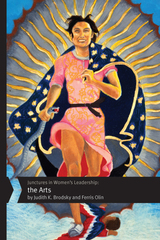 Junctures in Women's Leadership: The Arts
Brodsky, Judith K
Rutgers University Press, 2018 In this third volume of the series Junctures: Case Studies in Women’s Leadership, Judith K. Brodsky and Ferris Olin profile female leaders in music, theater, dance, and visual art. The diverse women included in Junctures in Women's Leadership: The Arts have made their mark by serving as executives or founders of art organizations, by working as activists to support the arts, or by challenging stereotypes about women in the arts. The contributors explore several important themes, such as the role of feminist leadership in changing cultural values regarding inclusivity and gender parity, as well as the feminization of the arts and the power of the arts as cultural institutions.
Amongst the women discussed are Bertha Honoré Palmer, Louise Noun, Samella Lewis, Julia Miles, Miriam Colón, Jaune Quick-To-See Smith, Bernice Steinbaum, Anne d’Harnoncourt, Martha Wilson, Jawole Willa Jo Zollar, Kim Berman, Gilane Tawadros, Joanna Smith, and Veomanee Douangdala.
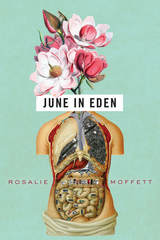 June in Eden
Rosalie Moffett
Ohio State University Press, 2017 Sometimes June in Eden occupies a garden in a wild landscape. Other times, we’re given a terrain where the coveted tree is one that hides a cell tower, where lungs are likened to ATMs and prayers are sent via text message. Rosalie Ruth Moffett’s debut collection of poetry, June in Eden, questions the human task of naming in a time where there are “new kinds of war that keep / changing the maps,” where little mistakes—preying or praying, for instance—are easily made. The heart of this book is an obsession with language, its slippages and power, what to do when faced with the loss of it. “Ruth,” says our speaker, is “a kind of compassion / nobody wants anymore—the surviving half / of the pair of words is ruthless.” There is, throughout this collection, a dark humor, but one that belies a tenderness or wonder, our human need to “love the world / we made and all its shadows.”
Rosalie Moffett’s June in Eden gives us a speaker bewildered by and in awe of the world: both the miracles and failures of technology, medicine, and imagination. These darkly humorous poems are works of grief and wonder and give us a landscape that looks, from some angles, like paradise.
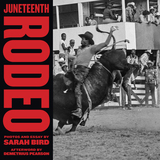 Juneteenth Rodeo
Photos and essay by Sarah Bird; Afterword by Demetrius Pearson
University of Texas Press, 2024 Award of Excellence — Communication Arts
Honorable Mention — The International Photography Awards 2024 Book Category
Jury Top 5 Selection — The International Photography Awards 2024 Book Category
Silver Winner in Zines And Photo Book/Culture— 2024 International Film Photography Award, Analog Sparks
Timeless photos offer a rare portrait of the jubilant, vibrant, vital, nearly hidden, and now all-but-vanished world of small-town Black rodeos. Long before Americans began to officially commemorate Juneteenth, in the heat of East Texas, saddles were being cinched, buckles shined, and lassoes adjusted for a day on the Black rodeo circuit in honor of the holiday. In the late 1970s, as they had been doing for generations, Black communities across the region held local rodeos for the talented cowboys and cowgirls who were segregated from the mainstream circuit. It was to these vibrant community events that bestselling Texas writer Sarah Bird, then a young photojournalist, found herself drawn. In Juneteenth Rodeo, Bird’s lens celebrates a world that was undervalued at the time, capturing everything, from the moment the pit master fired up his smoker, through the death-defying rides, to the last celebratory dance at a nearby honky-tonk. Essays by Bird and sports historian Demetrius Pearson reclaim the crucial role of Black Americans in the Western US and show modern rodeo riders—who still compete on today’s circuit—as “descendants” in a more than two-hundred-year lineage of Black cowboys. A gorgeous tribute to the ropers and riders—legends like Willie Thomas, Myrtis Dightman, Rufus Green, Bailey’s Prairie Kid, Archie Wycoff, and Calvin Greeley—as well as the secretaries, judges, and pick-up men and even the audience members who were as much family as fans, Juneteenth Rodeo ultimately seeks to put Black cowboys and cowgirls where they have always belonged: in the center of the frame.
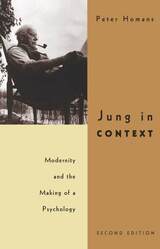 Jung in Context: Modernity and the Making of a Psychology
Peter Homans
University of Chicago Press, 1995 This provocative account of the origins, influences, and legacy of Jungian psychology is perhaps even more relevant today than it was when first published in 1979. By delineating the social, personal, religious, and cultural contexts of Jung's system of psychology, Homans identifies the central role of depth psychology in the culture of modernity. In this new edition, Homans has added an extensive foreword linking the core of Jungian psychology to contemporary works it has shaped—such as those of M. Scott Peck and Clarissa Pinkola Estes—that proclaim the power of Jungian concepts and theories to heal the alienated and isolated self in today's world.
"Jung in Context is an intellectual triumph. . . . Utilizes the resources of biography, psychology, sociology, and theology to probe the genesis of a psychological system which is currently enjoying a wide following. . . . A splendid job."—Lewis R. Rambo, Psychiatry
"Anyone seeking an introduction to Jung's thought will find a masterful précis here."—Jan Goldstein, Journal of Sociology
"An unusually perceptive and clearly written book. . . . An important advance in the understanding of Jung, and Homans's methodology sets the stage for all future efforts to understand psychological innovators."—Herbert H. Stroup, Christian Century
Jungian Literary Criticism
Richard P. Sugg
Northwestern University Press, 1992 Jungian Literary Criticism presents a comprehensive, theoretical foundation for a tradition of study that has included some of the leading critics of our time. This collection provides critics, writers, psychologists, and others interested in the relationship between psychology and literature with classics of Jungian literary analysis and with the work of contemporary scholars building on that tradition.
The Jungle
Upton Sinclair
University of Illinois Press, 1988 One of the most important American novels of the twentieth century, The Jungle shocked a nation with its horrifying depiction of the meatpacking industry and the dangerous labor performed by its impoverished, exploited workers. In this first annotated edition of Upton Sinclair's muckraking classic, James Barrett provides students and scholars with a broader understanding of the events and the milieu that led Sinclair to write the book.
 Jungle Fever: Exploring Madness and Medicine in Twentieth-Century Tropical Narratives
Charlotte Rogers
Vanderbilt University Press, 2012 The sinister "jungle"—that ill-defined and amorphous place where civilization has no foothold and survival is always in doubt—is the terrifying setting for countless works of the imagination. Films like Apocalypse Now, television shows like Lost, and of course stories like Heart of Darkness all pursue the essential question of why the unknown world terrifies adventurer and spectator alike. In Jungle Fever, Charlotte Rogers goes deep into five books that first defined the jungle as a violent and maddening place. The reader finds urban explorers venturing into the wilderness, encountering and living among the "native" inhabitants, and eventually losing their minds.
The canonical works of authors such as Joseph Conrad, Andre Malraux, Jose Eustasio Rivera, and others present jungles and wildernesses as fundamentally corrupting and dangerous. Rogers explores how the methods these authors use to communicate the physical and psychological maladies that afflict their characters evolved symbiotically with modern medicine. While the wilderness challenges Conrad's and Malraux's European travelers to question their civility and mental stability, Latin American authors such as Alejo Carpentier deftly turn pseudoscientific theories into their greatest asset, as their characters transform madness into an essential creative spark.
Ultimately, Jungle Fever suggests that the greatest horror of the jungle is the unknown regions of the character's own mind.
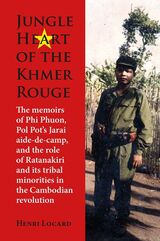 Jungle Heart of the Khmer Rouge: The memoirs of Phi Phuon, Pol Pot’s Jarai aide-de-camp, and the role of Ratanakiri and its tribal minorities in the Cambodian revolution
Henri Locard
National University of Singapore Press, 2023 The Khmer Rouge rise to power in 1975 gave birth to a terrifying new order marked by killings, forced ruralization and total collectivization. Up to two million people died as a result. The memoir of Phi Phuon, Pol Pot’s aide-de-camp/bodyguard – compiled and translated by Henri Locard with introduction, annotations, and background history and analysis – offers important new perspectives on the period. Though a relatively minor actor, Phi Phuon worked closely with the Khmer Rouge leadership. His quite candid account describes how an enterprising and idealistic young man was drawn to a revolutionary cause whose leadership he saw as patriotic, visionary and even charismatic. Moreover, Phi Phuon was Jarai, from one of the borderland hill tribes despised by many Khmer. Here, in the jungles of Ratanakiri Province as war in Vietnam raged nearby, Pol Pot and his urban, intellectual comrades mobilized the ethnic minorities into a revolutionary army. Inspired by idealized perceptions of hill-tribe lifestyles, the Khmer Rouge also developed radical plans for a civilizational blank slate that were implemented when they came to power. Shedding light on events not fully revealed before, this is a significant contribution to the study of recent Cambodian history.
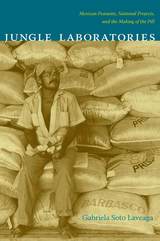 Jungle Laboratories: Mexican Peasants, National Projects, and the Making of the Pill
Gabriela Soto Laveaga
Duke University Press, 2009 In the 1940s chemists discovered that barbasco, a wild yam indigenous to Mexico, could be used to mass-produce synthetic steroid hormones. Barbasco spurred the development of new drugs, including cortisone and the first viable oral contraceptives, and positioned Mexico as a major player in the global pharmaceutical industry. Yet few people today are aware of Mexico’s role in achieving these advances in modern medicine. In Jungle Laboratories, Gabriela Soto Laveaga reconstructs the story of how rural yam pickers, international pharmaceutical companies, and the Mexican state collaborated and collided over the barbasco. By so doing, she sheds important light on a crucial period in Mexican history and challenges us to reconsider who can produce science. Soto Laveaga traces the political, economic, and scientific development of the global barbasco industry from its emergence in the 1940s, through its appropriation by a populist Mexican state in 1970, to its obsolescence in the mid-1990s. She focuses primarily on the rural southern region of Tuxtepec, Oaxaca, where the yam grew most freely and where scientists relied on local, indigenous knowledge to cultivate and harvest the plant. Rural Mexicans, at first unaware of the pharmaceutical and financial value of barbasco, later acquired and deployed scientific knowledge to negotiate with pharmaceutical companies, lobby the Mexican government, and ultimately transform how urban Mexicans perceived them. By illuminating how the yam made its way from the jungles of Mexico, to domestic and foreign scientific laboratories where it was transformed into pills, to the medicine cabinets of millions of women across the globe, Jungle Laboratories urges us to recognize the ways that Mexican peasants attained social and political legitimacy in the twentieth century, and positions Latin America as a major producer of scientific knowledge.
 Jungle of the Maya
Photographs by Douglas Goodell and Jerry Barrack, Text by Jim Wright
University of Texas Press, 2006 The Selva Maya (Jungle of the Maya) is one of the world's most magical yet least appreciated places—an enormous tropical forest that encompasses much of Belize, Guatemala, and Mexico's Yucatan Peninsula. At 9,000,000 acres, it is the largest contiguous tropical forest north of the Amazon in the Western Hemisphere. Within its borders, the Selva Maya provides habitat for an astonishing diversity of plants and animals—more than 500 species of birds alone. The forest also contains the fascinating ruins of ancient Maya cities, which attract visitors and researchers from all over the globe. Jungle of the Maya presents a stunning photographic portrait of this irreplaceable natural treasure. Nature photographers Douglas Goodell and Jerry Barrack capture the living wonders of the jungle—jaguars and other cats; spider and howler monkeys; hummingbirds and butterflies; and snakes, amphibians, and insects—as well as the region's hallmark Maya sites, including Tikal, Chichen Itza, Uxmal, and Tulum. Environmental writer Jim Wright invitingly describes the Selva Maya's natural and human history, helping visitors and residents appreciate the riches to be found in the forest and the need to protect and preserve them for generations to come. Because human activities are encroaching more and more on the Mayan forest, Jungle of the Maya is a beautiful book with a timely message. As renowned naturalist Archie Carr III sums it up in his foreword, "Today, the Selva Maya is at risk again. As modern beings, can we manage the forest better than we believe the ancient Maya did? We should. We have the archaeological record to draw from. We have modern science. And we still have inspiration whispered to us by spirits in the great plazas of Tikal and beyond. Turn the pages, and witness."
The Jungles of Arkansas: A Personal History of the Wonder State
Robert Lancaster
University of Arkansas Press, 1989 When H. L. Mencken wrote about "the miasmatic jungles of Arkansas," he was referring to the relative obscurity and uncertain image that Arkansas has enjoyed—or suffered from—throughout its history. In these entertaining and sometimes quirky essays, Lancaster sheds light on that image by analyzing the stereotypes that have characterized the state since its very beginning.
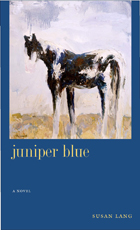 Juniper Blue: (A Novel)
Susan Lang
University of Nevada Press, 2006 This engrossing new novel by acclaimed author Susan Lang continues the saga of Ruth Farley, the fiercely independent young woman who was the protagonist of Small Rocks Rising, published by the University of Nevada Press in 2002. Ruth is still on her homestead at the end of a rugged canyon in California’s Mojave Desert, still struggling to survive on her own and to recover from a brutal rape and the murder of her lover. Now she must also face the responsibility of motherhood. The ensuing story expands Ruth’s world to encompass the panorama of Depression-era Southern California—miners and ranchers hanging on until times are better; Indians trying to preserve their ancient culture and identity; Okies, vagrants, and breadlines; the wealth and glitter of the movie industry; and narrow-minded small-town gossips. Ruth’s life also expands as she adjusts to motherhood, trying to maintain her autonomy and isolation and trying to preserve the tenuous web that links her to the seductive ruthlessness of the desert and to its ancient people and their wisdom. Ruth is one of the most engaging characters in recent fiction, complex and contradictory, stubborn and vulnerable, passionately in love with her austere desert home. Lang tells her story, the saga of a fully modern woman seeking her own identity and destiny against the turbulent, colorful setting of the rapidly changing twentieth-century West.
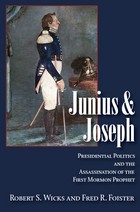 Junius And Joseph: Presidential Politics and the Assassination of the First Mormon Prophet
Robert S. Wicks & Fred R. Foister
Utah State University Press, 2005 "Junius and Joseph examines Joseph Smith's nearly forgotten [1844] presidential bid, the events leading up to his assassination on June 27, 1844, and the tangled aftermath of the tragic incident. It... establishes that Joseph Smith's murder, rather than being the deadly outcome of a spontaneous mob uprising, was in fact a carefully planned military-style execution. It is now possible to identify many of the key individuals engaged in planning his assassination as well as those who took part in the assault on Carthage jail. And furthermore, this study presents incontrovertible evidence that the effort to remove the Mormon leader from power and influence extended well beyond Hancock County [Illinois] (and included prominent Whig politicians as well as the Democratic governor of the state), thereby transforming his death from an impulsive act by local vigilantes into a political assassination sanctioned by some of the most powerful men in Illinois. The circumstances surrounding Joseph Smith's death also serve to highlight the often unrecognized truth that a full understanding of early Mormon history can be gained only when considered in the context of events taking place in American society as a whole."
The Junius B. Bird Pre-Columbian Textile Conference
Ann Pollard Rowe
Harvard University Press This volume, published jointly with the Textile Museum and based on the proceedings of the Dumbarton Oaks-Textile Museum conference of 1973, includes important contributions to the knowledge of Pre-Columbian textiles and weaving technology.
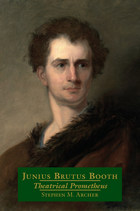 Junius Brutus Booth: Theatrical Prometheus
Stephen M. Archer
Southern Illinois University Press, 1992 In this, the first thoroughly researched scholarly biography of British actor Junius Brutus Booth, Stephen M. Archer reveals Booth to have been an artist of considerable range and a man of sensitivity and intellect. Archer provides a clear account of Booth’s professional and personal life and places him in relationship to his contemporaries, particularly Edmund Kean and William Charles Macready.
From 1817 to 1852 Junius Brutus Booth toured throughout North America, enjoying a reputation as the most distinguished Shakespearean tragedian on the American continent. Still, he yearned for success on the British stage, a goal he never attained. His public image as a drunken, dangerous lunatic obscured a private life filled with the richness of a close and loyal family. The worldwide fame assured for the Booth family of actors by John Wilkes Booth’s bone-shattering leap from the President’s box had eluded Junius Brutus Booth throughout his lifelong exile in America. But from that event until today, no American family of actors has stimulated such scrutiny as the Booths. Eight years of research, pursuing Booth from Amsterdam to San Francisco, has resulted in an accurate, fascinating narrative that both records and illuminates the actor’s life.
 Junk Drawer: What We Leave Behind
Sander Gilman
University of Delaware Press, 2026 Junk Drawer: What We Leave Behind explores the personal objects that were once treasured by their owners yet were ultimately consigned to online “junk drawer” sales. Photographer and coeditor Barbara Von Eckardt acquired these random assortments from estate remnants on eBay and has documented their contents through evocative, sepia-toned images. In doing so, she has breathed new life into items the world had deemed valueless, but that hint at the stories and identities of those who once owned them. In addition to the photographs, Von Eckardt and coeditor Sander L. Gilman have gathered essays by scholars across disciplines, each offering a unique perspective on how such everyday objects can carry profound meaning. The result is a “junk drawer” of reflections, as varied and thought-provoking as the artifacts themselves. It is a moving testament to the emotional and cultural resonance of ordinary things—and an invitation to look more deeply at the objects surrounding us.
 Junkware
Thierry Bardini
University of Minnesota Press, 2011 Are we made of junk? Thierry Bardini believes we are. Examining an array of cybernetic structures from genetic codes to communication networks, he explores the idea that most of culture and nature, including humans, is composed primarily of useless, but always potentially recyclable, material otherwise known as "junk."
Bardini unravels the presence of junk at the interface between science fictions and fictions of science, showing that molecular biology and popular culture since the early 1960s belong to the same culture-cyberculture-which is essentially a culture of junk. He draws on a wide variety of sources, including the writings of Philip K. Dick and William S. Burroughs, interviews with scientists as well as "crackpots," and work in genetics, cybernetics, and physics to support his contention that junk DNA represents a blind spot in our understanding of life.
At the same time, Junkware examines the cultural history that led to the encoding and decoding of life itself and the contemporary turning of these codes into a commodity. But he also contends that, beyond good and evil, the essential "junkiness" of this new subject is both the symptom and the potential cure.
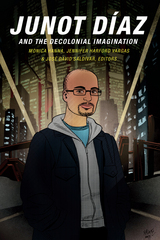 Junot Díaz and the Decolonial Imagination
Monica Hanna, Jennifer Harford Vargas, José David Saldívar, editors
Duke University Press, 2016 The first sustained critical examination of the work of Dominican-American writer Junot Díaz, this interdisciplinary collection considers how Díaz's writing illuminates the world of Latino cultural expression and trans-American and diasporic literary history. Interested in conceptualizing Díaz's decolonial imagination and his radically re-envisioned world, the contributors show how his aesthetic and activist practice reflect a significant shift in American letters toward a hemispheric and planetary culture. They examine the intersections of race, Afro-Latinidad, gender, sexuality, disability, poverty, and power in Díaz's work. Essays in the volume explore issues of narration, language, and humor in The Brief Wondrous Life of Oscar Wao, the racialized constructions of gender and sexuality in Drown and This Is How You Lose Her, and the role of the zombie in the short story "Monstro." Collectively, they situate Díaz’s writing in relation to American and Latin American literary practices and reveal the author’s activist investments. The volume concludes with Paula Moya's interview with Díaz. Contributors: Glenda R. Carpio, Arlene Dávila, Lyn Di Iorio, Junot Díaz, Monica Hanna, Jennifer Harford Vargas, Ylce Irizarry, Claudia Milian, Julie Avril Minich, Paula M. L. Moya, Sarah Quesada, José David Saldívar, Ramón Saldívar, Silvio Torres-Saillant, Deborah R. Vargas
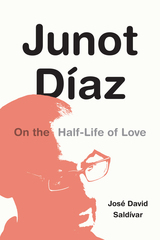 Junot Díaz: On the Half-Life of Love
José David Saldívar
Duke University Press, 2022 In Junot Díaz: On the Half-Life of Love, José David Saldívar offers a critical examination of one of the leading American writers of his generation. He explores Díaz’s imaginative work and the diasporic and immigrant world he inhabits, showing how his influences converged in his fiction and how his writing—especially his Pulitzer Prize--winning novel The Brief Wondrous Life of Oscar Wao—radically changed the course of US Latinx literature and created a new way of viewing the decolonial world. Saldívar examines several aspects of Díaz’s career, from his vexed relationship to the literary aesthetics of Whiteness that dominated his MFA experience and his critiques of the colonialities of power, race, and gender in culture and societies of the Dominican Republic, United States, and the Américas to his use of the science-fiction imaginary to explore the capitalist zombification of our planet. Throughout, Saldívar shows how Díaz’s works exemplify the literary currents of the early twenty-first century.
The Juntunen Site and the Late Woodland Prehistory of the Upper Great Lakes Area
Alan McPherron
University of Michigan Press, 1967 The Juntunen site was primarily a lakeside fishing village where sturgeon and whitefish were taken during their spawning season. The site, which is about 600 feet from the shore of Lake Huron, on the west end of Bois Blanc Island, was inhabited at intervals between about AD 800 and AD 1400 and is considered a Late Woodland site. In this volume, author Alan McPherron describes and analyzes the archaeological remains found at the site, including pottery, lithics, copper, bone, burials, and habitation features.
Jupiter: Studies of the interior, atmosphere, magnestosphere and satellites
Tom Gehrels
University of Arizona Press, 1976 When Jupiter was first published in August, 1976, editor T. Gehrels wrote, "we may never do a better book." Summarizing the research and data following the first flyby of Jupiter in December 1973, this work brings together the knowledge of the best scientists in the fields at the time of it's publication. The work covers the origin of Jupiter, origin and structure of the satellites, models of Jupiter, comparison of those models, and much more.
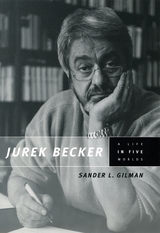 Jurek Becker: A Life in Five Worlds
Sander L. Gilman
University of Chicago Press, 2003 Jurek Becker, the author of the first comic novel on the Holocaust, Jacob the Liar, and other highly acclaimed works, was one of West Germany's most famous exiles from the GDR. A survivor of the Shoah-his mother died in a Nazi death camp-and witness to the Soviet occupation of Eastern Europe, Becker endured most of the trials that Jews experienced in Europe from the onset of World War II to the end of the Cold War.
In the first biography of this fascinating figure, Sander Gilman tells the story of Becker's life in five worlds: the Polish-Jewish middle-class neighborhood where Becker was born; the Warsaw ghetto and the concentration camps where Becker spent his childhood; the socialist order of the GDR, which Becker idealized, resisted, and finally was forced to leave; the isolated world of West Berlin, where he settled down to continue his writing; and the new, reunified Germany, for which Becker served as both conscience and inspiration.
Gilman was close friends with Becker for nearly thirty years, and his biography is based on unprecedented access to both the man and his papers. As Gilman reveals, Becker's story encapsulates the fractured experience of life in twentieth-century Europe, a time and place in which political systems and national borders were constantly in flux. The life of Becker, we learn, was one of great literary achievement and notoriety, but it was also one of profound cultural dislocation. An important theme in the book is Becker's struggle with his Jewishness, an identity he repressed in socialist East Germany, but embraced after reunification, when he found himself at the center of Jewish culture and literature.
Sander Gilman's story of Jurek Becker is biography of the highest order, a portrait of an extraordinarily gifted artist whose hope and courage are manifested in his legacy as one of the greatest German writers of the past century.
 Jurgen Habermas: Democracy and the Public Sphere
Luke Goode
Pluto Press, 2005 Habermas is a hugely influential thinker, yet his writing can be dense and inaccessible. This critical introduction offers undergraduates a clear way into Habermas’s concept of the ‘public sphere’ and its relevance to contemporary society. Luke Goode’s lively account also sheds new light on the ‘public sphere’ debate that will interest readers already familiar with Habermas’s work.
For Habermas, the 'public sphere' was a social forum that allowed people to debate -- whether it was the town hall or the coffee house, maintaining a space for public debate was an essential part of democracy. Habermas’s controversial work examines the erosion of these spaces within consumer society and calls for new thinking about democracy today.
Drawing on Habermas’s early and more recent writings, this book examines the ‘public sphere’ in its full complexity, outlining its relevance to today’s media and culture. It will be of interest to students and scholars in a range of disciplines across the social sciences and humanities.
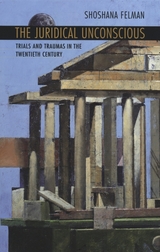 The Juridical Unconscious: Trials and Traumas in the Twentieth Century
Shoshana Felman
Harvard University Press, 2002 Death, wrote Walter Benjamin, lends storytellers all their authority. How do trials, in turn, borrow their authority from death? This book offers a groundbreaking account of the surprising interaction between trauma and justice.
Moving from texts by Arendt, Benjamin, Freud, Zola, and Tolstoy to the Dreyfus and Nuremberg trials, as well as the trials of O. J. Simpson and Adolf Eichmann, Shoshana Felman argues that the adjudication of collective traumas in the twentieth century transformed both culture and law. This transformation took place through legal cases that put history itself on trial, and that provided a stage for the expression of the persecuted--the historically "expressionless."
Examining legal events that tried to repair the crimes and injuries of history, Felman reveals the "juridical unconscious" of trials and brilliantly shows how this juridical unconscious is bound up with the logic of the trauma that a trial attempts to articulate and contain but so often reenacts and repeats. Her book gives the drama of the law a new jurisprudential dimension and reveals the relation between law and literature in a new light.
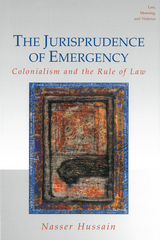 The Jurisprudence of Emergency: Colonialism and the Rule of Law
Nasser Hussain
University of Michigan Press, 2003 Ever-more-frequent calls for the establishment of a rule of law in the developing world have been oddly paralleled by the increasing use of "exceptional" measures to deal with political crises. To untangle this apparent contradiction, The Jurisprudence of Emergency analyzes the historical uses of a range of emergency powers, such as the suspension of habeas corpus and the use of military tribunals. Nasser Hussain focuses on the relationship between "emergency" and the law to develop a subtle new theory of those moments in which the normative rule of law is suspended. The Jurisprudence of Emergency examines British colonial rule in India from the late eighteenth to the early twentieth century in order to trace tensions between the ideology of liberty and government by law, which was used to justify the British presence, and the colonizing power's concurrent insistence on a regime of conquest. Hussain argues that the interaction of these competing ideologies exemplifies a conflict central to all Western legal systems—between the universal, rational operation of law on the one hand and the absolute sovereignty of the state on the other. The author uses an impressive array of historical evidence to demonstrate how questions of law and emergency shaped colonial rule, which in turn affected the development of Western legality. The pathbreaking insights developed in The Jurisprudence of Emergency reevaluate the place of colonialism in modern law by depicting the colonies as influential agents in the interpretation and delineation of Western ideas and practices. Hussain's interdisciplinary approach and subtly shaded revelations will be of interest to historians as well as scholars of legal and political theory.
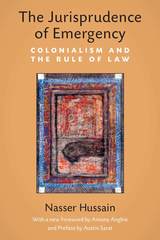 The Jurisprudence of Emergency: Colonialism and the Rule of Law
Nasser Hussain
University of Michigan Press, 2019 The Jurisprudence of Emergency examines British rule in India from the late eighteenth to the early twentieth century, tracing tensions between the ideology of liberty and government by law used to justify the colonizing power's insistence on a regime of conquest. Nasser Hussain argues that the interaction of these competing ideologies exemplifies a conflict central to all Western legal systems—between the universal, rational operation of law on the one hand and the absolute sovereignty of the state on the other. The author uses an impressive array of historical evidence to demonstrate how questions of law and emergency shaped colonial rule, which in turn affected the development of Western legality.
The pathbreaking insights developed in The Jurisprudence of Emergency reevaluate the place of colonialism in modern law by depicting the colonies as influential agents in the interpretation of Western ideas and practices. Hussain's interdisciplinary approach and subtly shaded revelations will be of interest to historians as well as scholars of legal and political theory.
 Jurisprudence: The Philosophy and Method of the Law, Revised Edition
Edgar Bodenheimer
Harvard University Press, 1974 When Edgar Bodenheimer’s book, Jurisprudence: The Philosophy and Method of the Law, was published in 1962, it received extraordinary reviews. It was called by one commentator “a profoundly scholarly, clearly written and thoroughly unpretentious contribution to the literature of jurisprudence.” Because there have been significant developments in analytical jurisprudence and in the legal philosophy of values, Bodenheimer has brought his book up to date.
Part I now includes a discussion of important recent contributions to jurisprudence. Part II has been largely rewritten to give more extensive consideration to the psychological roots of the need for order and quest for justice, the conceptual scope and substantive components of the notion of justice, and the criteria for validity of the law. Part III of Bodenheimer’s study is concerned with the problems of legal method and the modes of legal reasoning.
 Jurors' Stories of Death: How America's Death Penalty Invests in Inequality
Benjamin Fleury-Steiner
University of Michigan Press, 2004 "What is most extraordinary about Ben Fleury-Steiner's book is that it seeks to shed light on the 'black box' of capital jury deliberations. Based on a remarkable social science survey of persons who served on capital juries, this volume illuminates the workings of the most closely guarded secret in the criminal justice system."
-David Cole, from the Foreword
"Perhaps the most powerful, routinely enacted civic ritual in American public life is that of capital punishment. This state-sanctioned extirpation of human life in the collective pursuit of justice is a searing act of civic pedagogy, made legitimate only by the deliberative endorsement of a small group of ordinary citizens-the jury. In Jurors' Stories of Death, Benjamin Fleury-Steiner has taken a cold, hard look at how these ordinary citizens come to terms with their extraordinary role, and how they rationalize their irreversible decisions. The result is a chilling portrait of how we---that is, all of us Americans---constitute ourselves as a political community."
-Glenn Loury, Director, Institute on Race and Social Division
"This illuminating and insightful examination of jury deliberations makes a terrific contribution to the study of capital punishment. Fleury-Steiner's synthesis of sociological, legal and theoretical concepts with vivid juror narratives and statistical data, thoughtfully animates and details how race and class consciousness continue to shape America's death penalty."
---Bryan Stevenson, Professor of Clinical Law, NYU School of Law, Executive Director, Equal Justice Initiative of Alabama
Jurors' Stories of Death is more than just another book on the death penalty; it is the first systematic survey of how death penalty decisions are made.
Benjamin Fleury-Steiner draws on real-life accounts of white and black jurors in capital punishment trials to discuss the effect of race on the sentencing process. He finds that race is invariably a factor in sentencing, with jurors relying on accounts that deny the often marginalized defendants their individuality and complexity, while reinforcing the jurors' own identities as superior, moral, and law-abiding citizens-a system that punishes in the name of dominance. This biased story of "us versus them" continues to infuse political rhetoric on crime and punishment in the United States even today.
Jurors' Stories of Death concludes with an original argument for abolition of the death penalty: If America values multiculturalism and cultural diversity, it must do away with institutions such as state-sanctioned capital punishment in order to begin to free itself from the racism and classicism that so insidiously plague social relations today.
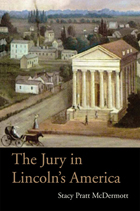 The Jury in Lincoln’s America
Stacy Pratt McDermott
Ohio University Press, 2012 In the antebellum Midwest, Americans looked to the law, and specifically to the jury, to navigate the uncertain terrain of a rapidly changing society. During this formative era of American law, the jury served as the most visible connector between law and society. Through an analysis of the composition of grand and trial juries and an examination of their courtroom experiences, Stacy Pratt McDermott demonstrates how central the law was for people who lived in Abraham Lincoln’s America. McDermott focuses on the status of the jury as a democratic institution as well as on the status of those who served as jurors. According to the 1860 census, the juries in Springfield and Sangamon County, Illinois, comprised an ethnically and racially diverse population of settlers from northern and southern states, representing both urban and rural mid-nineteenth-century America. It was in these counties that Lincoln developed his law practice, handling more than 5,200 cases in a legal career that spanned nearly twenty-five years. Drawing from a rich collection of legal records, docket books, county histories, and surviving newspapers, McDermott reveals the enormous power jurors wielded over the litigants and the character of their communities.
The Just
Paul Ricoeur
University of Chicago Press, 2000 The essays in this book contain some of Paul Ricoeur's most fascinating ruminations on the nature of justice and the law. His thoughts ranging across a number of topics and engaging the work of thinkers both classical and contemporary, Ricoeur offers a series of important reflections on the juridical and the philosophical concepts of right and the space between moral theory and politics.
 Just a Dog: Animal Cruelty, Self, and Society
Arnold Arluke
Temple University Press, 2006 Psychiatrists define cruelty to animals as a psychological problem or personality disorder. Legally, animal cruelty is described by a list of behaviors. In Just a Dog, Arnold Arluke argues that our current constructs of animal cruelty are decontextualized—imposed without regard to the experience of the groups committing the act. Yet those who engage in animal cruelty have their own understandings of their actions and of themselves as actors. In this fascinating book, Arluke probes those understandings and reveals the surprising complexities of our relationships with animals. Just a Dog draws from interviews with more than 250 people, including humane agents who enforce cruelty laws, college students who tell stories of childhood abuse of animals, hoarders who chronically neglect the welfare of many animals, shelter workers who cope with the ethics of euthanizing animals, and public relations experts who use incidents of animal cruelty for fundraising purposes. Through these case studies, Arluke shows how the meaning of "cruelty" reflects and helps to create identities and ideologies.
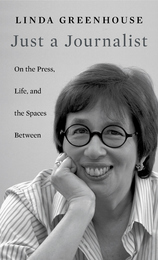 Just a Journalist: On the Press, Life, and the Spaces Between
Linda Greenhouse
Harvard University Press, 2017 In this timely book, a Pulitzer Prize–winning reporter trains an autobiographical lens on a moment of remarkable transition in American journalism. Just a few years ago, the mainstream press was wrestling with whether labeling waterboarding as torture violated important norms of neutrality and objectivity. Now, major American newspapers regularly call the president of the United States a liar. Clearly, something has changed as the old rules of “balance” and “two sides to every story” have lost their grip. Is the change for the better? Will it last?
In Just a Journalist, Linda Greenhouse—who for decades covered the U.S. Supreme Court for The New York Times—tackles these questions from the perspective of her own experience. A decade ago, she faced criticism from her own newspaper and much of journalism’s leadership for a speech to a college alumnae group in which she criticized the Bush administration for, among other things, seeking to create a legal black hole at Guantánamo Bay—two years after the Supreme Court itself had ruled that the detainees could not be hidden away from the reach of federal judges who might hear their appeals.
One famous newspaper editor expressed his belief that it was unethical for a journalist to vote, because the act of choosing one candidate over another could compromise objectivity. Linda Greenhouse disagrees. Calling herself “an accidental activist,” she raises urgent questions about the role journalists can and should play as citizens, even as participants, in the world around them.
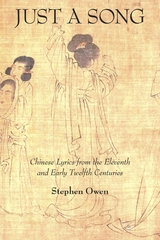 Just a Song: Chinese Lyrics from the Eleventh and Early Twelfth Centuries
Stephen Owen
Harvard University Press, 2019 “Song Lyric,” ci, remains one of the most loved forms of Chinese poetry. From the early eleventh century through the first quarter of the twelfth century, song lyric evolved from an impromptu contribution in a performance practice to a full literary genre, in which the text might be read more often than performed. Young women singers, either indentured or private entrepreneurs, were at the heart of song practice throughout the period; the authors of the lyrics were notionally mostly male. A strange gender dynamic arose, in which men often wrote in the voice of a woman and her imagined feelings, then appropriated that sensibility for themselves.
As an essential part of becoming literature, a history was constructed for the new genre. At the same time the genre claimed a new set of aesthetic values to radically distinguish it from older “Classical Poetry,” shi. In a world that was either pragmatic or moralizing (or both), song lyric was a discourse of sensibility, which literally gave a beautiful voice to everything that seemed increasingly to be disappearing in the new Song dynasty world of righteousness and public advancement.
 Just A Temp
Kevin Henson
Temple University Press, 1996 "So this is where the brain starts to shut down and that which we treasure most, our personal identities, begins to slip away....I suppose I should be thankful; it's a paycheck." With this disturbing sentiment, Kevin Henson begins a voyage into the world of "the temp." For several years while a graduate student, Henson logged in thousands of hours as a temporary worker in offices throughout Chicago's Loop. Those experiences, and numerous interviews with other temps and temporary counselors, create a vivid and often disheartening picture of working 9 to 5 behind the receptionist's desk, telephone console, or data-entry terminal. In their own voices, the temps in this book lament the frequently demeaning and mundane nature of many assignments: • "You're not paid to think." • "Temps don't have names; they are just 'the temp.'" • "They always harass me...because I just wear a sweater and slacks." • "The worst part is telling people what you do. They always ask 'When are you going to get a real job?'" Where the temporary service industry is quick to extol the virtues of temp work—mainly its flexibility—Henson and his cast of temps reveal the tacit pressure to persevere through an unpleasant assignment, to accept every assignment offered, and to readjust personal lives to do so. Outsiders to the established office culture and hierarchy, most temps are asked to do low-skill work and leave more detailed or complicated tasks for the return of the permanent employee. Whether temp life is a preferred choice or grudgingly accepted as the last option when "real" or permanent work is unavailable, all temps must confront issues of gender, identity, and self-esteem. Henson examines these issues, documenting the concerns and interpretations of temp workers about their own work lives.
|
|

